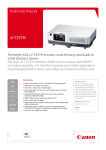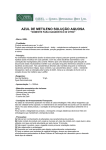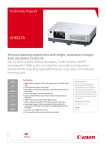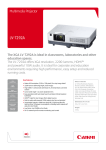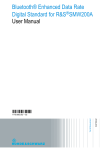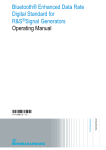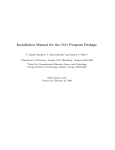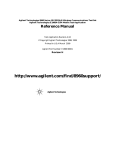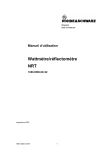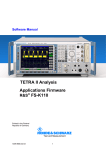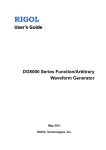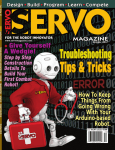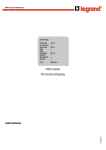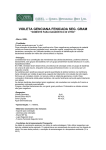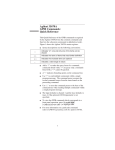Download Digital Standard: TETRA Release 2
Transcript
TETRA Release 2 Digital Standard for R&S®SMW200A User Manual (;ÙÒ:2) User Manual Test & Measurement 1175.6810.02 ─ 02 This document describes the following software options: ● R&S®SMW-K68 1413.4439.02 © 2013 Rohde & Schwarz GmbH & Co. KG Mühldorfstr. 15, 81671 München, Germany Phone: +49 89 41 29 - 0 Fax: +49 89 41 29 12 164 E-mail: [email protected] Internet: www.rohde-schwarz.com Subject to change – Data without tolerance limits is not binding. R&S® is a registered trademark of Rohde & Schwarz GmbH & Co. KG. Trade names are trademarks of the owners. The following abbreviations are used throughout this manual: R&S®SMW200A is abbreviated as R&S SMW, R&S®WinIQSIM2 is abbreviated as R&S WinIQSIM2 TETRA Release 2 Contents Contents 1 Preface....................................................................................................5 1.1 Documentation Overview.............................................................................................5 1.2 Conventions Used in the Documentation...................................................................6 1.2.1 Typographical Conventions.............................................................................................6 1.2.2 Conventions for Procedure Descriptions.........................................................................7 2 Introduction............................................................................................8 3 TETRA2 Configuration and Settings....................................................9 3.1 General Settings............................................................................................................9 3.2 Trigger Settings...........................................................................................................13 3.3 Marker Settings...........................................................................................................17 3.4 Clock Settings.............................................................................................................20 3.5 Local and Global Connector Settings.......................................................................21 3.6 Frame Configuration Settings....................................................................................22 3.7 Burst Editor.................................................................................................................22 3.8 BSCH / BNCH/T...........................................................................................................26 3.8.1 TETRA Frequency........................................................................................................27 3.8.2 Contents Settings..........................................................................................................29 3.8.3 Scrambling....................................................................................................................32 3.9 Filter / Clipping Settings.............................................................................................33 3.9.1 Filter Settings................................................................................................................34 3.9.2 Modulation Settings.......................................................................................................34 3.9.3 Clipping Settings...........................................................................................................35 3.10 Power Ramp Control...................................................................................................36 4 Remote Control Commands................................................................39 4.1 Primary Settings..........................................................................................................40 4.2 Power Ramp Settings.................................................................................................45 4.3 Slot Configuration Settings........................................................................................47 4.4 BSCH / BNCH/T Settings............................................................................................55 4.5 Trigger/Marker/Clock Settings...................................................................................63 4.5.1 Clock Settings...............................................................................................................63 User Manual 1175.6810.02 ─ 02 3 TETRA Release 2 Contents 4.5.2 Trigger Settings.............................................................................................................64 4.5.3 Marker Settings.............................................................................................................70 4.6 Filter/Clipping Settings...............................................................................................72 List of Commands................................................................................75 Index......................................................................................................78 User Manual 1175.6810.02 ─ 02 4 TETRA Release 2 Preface Documentation Overview 1 Preface 1.1 Documentation Overview The user documentation for the R&S SMW consists of the following parts: ● Getting Started printed manual ● Online Help system on the instrument ● Documentation CD-ROM with: – Getting Started – Online help system (*.chm) as a standalone help – User Manuals for base unit and options – Service manual – Data sheet and product brochure – Links to useful sites on the R&S internet Online Help The Online Help is embedded in the software. It offers quick, context-sensitive access to the complete information needed for operation and programming. The online help contains help on operating the R&S SMW and all available options. Getting Started This manual is delivered with the instrument in printed form and in PDF format on the documentation CD. It provides the information needed to set up and start working with the instrument. Basic operations and typical measurement examples are described. Safety information is also included. User Manual User manuals are provided for the base unit and each additional (software) option. The user manual for the base unit is a supplement to the Getting Started manual and provides basic information on operating the R&S SMW in general. In this manual, all instrument functions are described in detail. Furthermore, it provides a complete description of the remote control commands with programming examples. An introduction to remote control is provided, as well as information on maintenance, instrument interfaces and troubleshooting. In the user manuals for the individual software options, the specific instrument functions of this option are described in detail. For additional information on default settings and parameters, refer to the data sheets. Basic information on operating the R&S SMW is not included in these user manuals. The user manuals are available in PDF format - in printable form - on the Documentation CD-ROM delivered with the instrument. User Manual 1175.6810.02 ─ 02 5 TETRA Release 2 Preface Conventions Used in the Documentation All user manuals are also available for download from the R&S website, on the R&S SMW product page at http://www.rohde-schwarz.com/product/SMW.html. Service Manual This manual is available in PDF format on the CD delivered with the instrument. It describes how to check compliance with rated specifications, instrument function, repair, troubleshooting and fault elimination. It contains all information required for repairing the R&S SMW by replacing modules. Release Notes The release notes describe the installation of the firmware, new and modified functions, eliminated problems, and last minute changes to the documentation. The corresponding firmware version is indicated on the title page of the release notes. The most recent release notes are available for download from the R&S website, on the R&S SMW product page at http://www.rohde-schwarz.com/product/SMW.html > Downloads > Firmware. Web Helps Web helps are provided for the base unit and each additional (software) option. The content of the web helps correspond to the user manuals for the latest product versions. The web help is an additional file format that offers quick online access. The web helps are not intended for download but rather to access the required information directly form the R&S website. Web helps are available at the R&S website, on the R&S SMW product page at http:// www.rohde-schwarz.com/product/SMW.html > Download > Web Help. 1.2 Conventions Used in the Documentation 1.2.1 Typographical Conventions The following text markers are used throughout this documentation: Convention Description "Graphical user interface elements" All names of graphical user interface elements on the screen, such as dialog boxes, menus, options, buttons, and softkeys are enclosed by quotation marks. KEYS Key names are written in capital letters. File names, commands, program code File names, commands, coding samples and screen output are distinguished by their font. Input Input to be entered by the user is displayed in italics. User Manual 1175.6810.02 ─ 02 6 TETRA Release 2 Preface Conventions Used in the Documentation Convention Description Links Links that you can click are displayed in blue font. "References" References to other parts of the documentation are enclosed by quotation marks. 1.2.2 Conventions for Procedure Descriptions When describing how to operate the instrument, several alternative methods may be available to perform the same task. In this case, the procedure using the touchscreen is described. Any elements that can be activated by touching can also be clicked using an additionally connected mouse. The alternative procedure using the keys on the instrument or the on-screen keyboard is only described if it deviates from the standard operating procedures. The term "select" may refer to any of the described methods, i.e. using a finger on the touchscreen, a mouse pointer in the display, or a key on the instrument or on a keyboard. User Manual 1175.6810.02 ─ 02 7 TETRA Release 2 Introduction 2 Introduction The R&S Signal Generator provides you with the ability to generate signals in accordance with the standard Terrestrial Trunked Radio Release 2 (TETRA2) . The following list gives an overview of the main options provided by the R&S Signal Generator for generating an TETRA signal in accordance with ETSI EN 300 392-2. ● The TETRA frame (bit stream) is generated according to the selected burst type, i.e. control burst (CB), normal burst (NB) or synchronization burst (SB). ● The frames are generated for the uplink (mobile station [MS] transmitting) or the downlink (base station [BS] transmitting). ● The channel types AACH, BSCH, BNCH, TCH, STCH, SCH as well as the TETRA Release 2 specific channels like SCH-Q, etc. are generated. ● Channel coding including scrambling with system code, base color code, mobile country code and mobile network code is performed for all channels. ● Frame repetition can be selected via sequence length. ● The T1 test signal is generated for the V+D (voice and data) test on MS and BS DUTs. ● Test channel types can be set for the downlink and for the uplink. ● The bit stream can be generated either from pseudo-random sequences (CCITT O. 153) or from user-selectable sequences. ● The R&S Signal Generator calculates the appropriate TETRA2 T1, T2, T3 and T4 signal according to the specifiction. ● Additionaly, user-defined test signal can be generated. User Manual 1175.6810.02 ─ 02 8 TETRA Release 2 TETRA2 Configuration and Settings General Settings 3 TETRA2 Configuration and Settings ► To access the TETRA2 settings, select "Baseband > TETRA". The remote commands required to define these settings are described in chapter 4, "Remote Control Commands", on page 39 3.1 General Settings This dialog provides access to the default, the "Save/Recall" settings and to the settings for selection of a test mode, channel type and link direction. ► To access this dialog select "Baseband > TETRA > General". This dialog comprises the standard general settings, valid for the signal in both transmission directions. Provided are the following settings: State Enables/disables the TETRA standard. User Manual 1175.6810.02 ─ 02 9 TETRA Release 2 TETRA2 Configuration and Settings General Settings Enabling this standard disables all the other digital standards and digital modulation modes in the same baseband. Remote command: [:SOURce<hw>]:BB:TETRa:STATe on page 44 Set to Default Calls the default settings. The values of the main parameters are listed in the following table. Parameter Value "State" Off "Test Mode" T1 "Link Direction" Downlink / Forward "Channel Type" 0 "Sequence Length" 1 Multiframe "Power Ramp/Slot Attenuation" cosine/ 2 / 0 / 0sym "Filter/Clipping" Root Cosine / clipping Off "Trigger/Marker" Auto/ Int "Clock" Internal Remote command: [:SOURce<hw>]:BB:TETRa:PRESet on page 41 Save/Recall Accesses the "Save/Recall" dialog, i.e. the standard instrument function for storing and recalling the complete dialog related settings in a file. The provided navigation possibilities in the dialog are self-explanatory. The file name and the directory it is stored in are user-definable; the file extension is however predefined. See also, chapter "File and Data Management" in the R&S SMW User Manual. Remote command: [:SOURce<hw>]:BB:TETRa:SETTing:LOAD on page 42 [:SOURce<hw>]:BB:TETRa:SETTing:STORe on page 42 [:SOURce<hw>]:BB:TETRa:SETTing:STORe:FAST on page 43 [:SOURce<hw>]:BB:TETRa:SETTing:CATalog? on page 41 [:SOURce<hw>]:BB:TETRa:SETTing:DELete on page 42 Generate Waveform File With enabled signal generation, triggers the instrument to store the current settings as an ARB signal in a waveform file. Waveform files can be further processed by the ARB and/or as a multi carrier or a multi segment signal. User Manual 1175.6810.02 ─ 02 10 TETRA Release 2 TETRA2 Configuration and Settings General Settings The file name and the directory it is stored in are user-definable; the predefined file extension for waveform files is *.wv. Remote command: [:SOURce<hw>]:BB:TETRa:WAVeform:CREate on page 44 Test Mode Selects the test mode. Several settings depends on the selected test model. "T1" Test signal T1 (TETRA wanted signal, phase modulated) This test mode enables the generation of test signal that comply with the TETRA air interface multiframe, frame and slot structure. The T1 test signal is generated according to EN 300 394-1V3.1.1 and is intended to be the wanted signal transmitted by the test system during frames 1 to 17 in all receiver tests. The signal is pi/4-DQPSK or pi/8-D8PSK modulated. Frame 18 transmits information for control purposes. To enable configuration of the T1 signal for different receiver tests, the channel type for the "T1" signal is user-selectable. Channel types 0 to 4, 21, 22 and 25 are available in the Downlink/Forward "Link Direction" and channel types 7 to 11, 21, 23 and 24 for the Uplink/Reverse direction. The burst types Uplink/Reverse and Downlink/Forward are derived from the channel types. The instrument generates the Tx data for complete multiframes for the V+D service (voice and data). The contents of data fields are automatically inserted according to the burst type. The control block (cb), blocks 1 + 2 (bk), the synchronization block (sb) and the broadcast block (bb) for test signal T1 are generated according to the frame number and the channel type. "T4" Test signal T4 (TETRA wanted signal, QAM modulated) The test signal T4 comply with the TETRA air interface multiframe, frame and slot structure. The T4 test signal is intended to be the wanted signal transmitted by the test system during frames 1 to 17 in all receiver tests. Except form frame 18, the signal is 4-QAM, 16-QAM or 64-QAM modulated. Frame 18 transmits information for control purposes and is QAM and phase modulated (QAM + pi/4-DQPSK); the frame is generated according to EN 300 394-1. "User Defined" Enables the generation of user-defined test signal. "T2" Test signal T2 (TETRA interfer) The T2 test signal is phase or QAM modulated, depending on the selected Modulation Type. "T3" Test sugnal T3 (unmodulated interferer) The T3 test signal is an unmodulated continuous sinusoidal out-of-band interfering signal. Remote command: [:SOURce<hw>]:BB:TETRa:TMODe on page 44 User Manual 1175.6810.02 ─ 02 11 TETRA Release 2 TETRA2 Configuration and Settings General Settings Link Direction Selects the transmission direction. This parameter determines the available "Channel Types". "Downlink/Forward" The transmission direction selected is from the base station (BS) to the terminal (MS). The signal corresponds to that of a BS. "Uplink/ Reverse" The transmission direction selected is from MS to the BS. The signal corresponds to that of a terminal. Remote command: [:SOURce<hw>]:BB:TETRa:LDIRection on page 40 Channel Type (for "Test Model" set to T1 or T4) Determines the channel type. Remote command: [:SOURce<hw>]:BB:TETRa:CTYPe on page 40 Modulation Type (for "Test Model" set to User Defined or T2) Determines the modulation type, "Phase" or "QAM." "Phase" The T2 test signal is a pi/4-DQPSK modulated continuous radio signal. "QAM" The T2 test signal is 4-QAM, 16-QAM or 64-QAM modulated and spans a bandwidth of 25kHz, 50kHz, 100kHz or 150kHz. Remote command: [:SOURce<hw>]:BB:TETRa:MTYPe on page 41 Downlink Burst Type (in Downlink "Link Direction" and for "Test Model" set to T2 or User Defined) Determines whether a discontinuous or continuous downlink burst type is used. Remote command: [:SOURce<hw>]:BB:TETRa:DBTYpe on page 40 Sequence Length Selects the sequence length of the arbitrary waveform file in the number of multiframes. One multiframe is the minimum sequence length for a T1 signal. Remote command: [:SOURce<hw>]:BB:TETRa:SLENgth on page 43 Power Ramp/Slot Attenuations Calls the "Power Ramp Control" dialog. This dialog is used to set the power ramping parameters and for setting values for the level attenuation in dB (see chapter 3.10, "Power Ramp Control", on page 36). The currently selected ramp function and ramp time are displayed. User Manual 1175.6810.02 ─ 02 12 TETRA Release 2 TETRA2 Configuration and Settings Trigger Settings BSCH / BNCH/T Accesses the "BSCH / BNCH/T" dialog, used to configure the frequency settings, the scrambling code and the content of the Broadcast Synchronization Channel (BSCH) and the Broadcast Network Channel (BNCH/T), see chapter 3.8, "BSCH / BNCH/T", on page 26. Filter / Clipping Access to the dialog for setting baseband filtering, clipping and the sequence length of the arbitrary waveform component, see chapter 3.9, "Filter / Clipping Settings", on page 33. 3.2 Trigger Settings This tab provides access to the settings necessary to select and configure the trigger, like trigger source, mode, trigger delay, trigger suppression, as well as to arm or trigger an internal trigger manually. The current signal generation status is displayed in the header of the tab together with information on the enabled trigger mode. As in the "Marker" and "Clock" tabs, this tab provides also an access to the settings of the related connectors. This section focuses on the available settings. For information on how these settings affect the signal, refer to chapter "Basics" in the R&S SMW user manual. ► To access this dialog, select "Baseband > TETRA > Trigger In". This dialog comprises the settings required for configuring the trigger signal. User Manual 1175.6810.02 ─ 02 13 TETRA Release 2 TETRA2 Configuration and Settings Trigger Settings Routing and Enabling a Trigger The provided trigger signals are not dedicated to a particular connector but can be mapped to one or more globally shared USER or local T/M/(C) connectors. Use the Local and Global Connector Settings to configure the signal mapping as well as the polarity, the trigger threshold and the input impedance of the input connectors. To route and enable a trigger signal, perform the following general steps: ● Define the signal source and the effect of a trigger event, i.e. select the "Trigger In > Mode" and "Trigger In > Source" ● Define the connector, USER or T/M/(C), the selected signal is provided at, i.e. configure the Local and Global Connector Settings. Trigger Mode Selects trigger mode, i.e. determines the effect of a trigger event on the signal generation. Note: To enable simultaneous signal generation in all basebands, the trigger settings in the available basebands are coupled in any instrument's configuration involving signal routing with signal addition (e.g. MIMO configuration, routing and summing of basebands and/or streams). For more information, refer to chapter "Basics" in the R&S SMW user manual. ● ● ● ● ● "Auto" The signal is generated continuously. "Retrigger" The signal is generated continuously. A trigger event (internal or external) causes a restart. "Armed_Auto" The signal is generated only when a trigger event occurs. Then the signal is generated continuously. An "Arm" stops the signal generation. A subsequent trigger event (internal with or external) causes a restart. "Armed_Retrigger" The signal is generated only when a trigger event occurs. Then the signal is generated continuously. Every subsequent trigger event causes a restart. An "Arm" stops signal generation. A subsequent trigger event (internal with or external) causes a restart. "Single" The signal is generated only when a trigger event occurs. Then the signal is generated once to the length specified at "Signal Duration". Every subsequent trigger event (internal or external) causes a restart. Remote command: [:SOURce<hw>]:BB:TETRa:TRIGger:SEQuence on page 69 Signal Duration Unit Defines the unit for describing the length of the signal sequence to be output in the "Single" trigger mode. Remote command: [:SOURce<hw>]:BB:TETRa:TRIGger:SLUNit on page 67 User Manual 1175.6810.02 ─ 02 14 TETRA Release 2 TETRA2 Configuration and Settings Trigger Settings Trigger Signal Duration Enters the length of the signal sequence to be output in the "Single" trigger mode. The input is expressed in the signal units. Use this parameter to deliberately output part of the signal, an exact sequence of the signal, or a defined number of repetitions of the signal. Remote command: [:SOURce<hw>]:BB:TETRa:TRIGger:SLENgth on page 67 Running/Stopped For enabled modulation, displays the status of signal generation for all trigger modes. ● ● "Running" The signal is generated; a trigger was (internally or externally) initiated in triggered mode. "Stopped" The signal is not generated and the instrument waits for a trigger event. Remote command: [:SOURce<hw>]:BB:TETRa:TRIGger:RMODe on page 66 Arm Stops the signal generation until subsequent trigger event occurs. Remote command: [:SOURce<hw>]:BB:TETRa:TRIGger:ARM:EXECute on page 64 Execute Trigger For internal trigger source, executes trigger manually. Remote command: [:SOURce<hw>]:BB:TETRa:TRIGger:EXECute on page 65 Trigger Source Note: To enable simultaneous signal generation in all basebands, the trigger settings in the available basebands are coupled in any instrument's configuration involving signal routing with signal addition (e.g. MIMO configuration, routing and summing of basebands and/or streams). For more information, refer to chapter "Basics" in the R&S SMW user manual. The following sources of the trigger signal are available: ● "Internal" The trigger event is executed manually by the "Execute Trigger". ● "Internal (Baseband A/B)" The trigger event is provided by the trigger signal from the other basebands. ● "External Global Trigger 1 / 2" The trigger event is the active edge of an external trigger signal provided and configured at the global USER connectors. ● "External Global Clock 1 / 2" The trigger event is the active edge of an external global clock signal provided and configured at the global USER connectors. ● "External Local Trigger" User Manual 1175.6810.02 ─ 02 15 TETRA Release 2 TETRA2 Configuration and Settings Trigger Settings ● The trigger event is the active edge of an external trigger signal provided and configured at the local T/M/(C) connector. With coupled trigger settings, the signal has to be provided at the T/M/C 1/2/3 connectors. "External Local Clock" The trigger event is the active edge of an external local clock signal provided and configured at the local T/M/C connector. With coupled trigger settings, the signal has to be provided at the T/M/C 1 connector. Remote command: [:SOURce<hw>]:BB:TETRa:TRIGger:SOURce on page 67 Sync. Output to External Trigger For an external trigger signal, enables/disables the output of a signal synchronous to the external trigger event. "On" User Manual 1175.6810.02 ─ 02 Corresponds to the default state of this parameter. The signal calculation starts simultaneously with the external trigger event but because of the instrument’s processing time the first samples are cut off and no signal is output. After elapsing of the internal processing time, the output signal is synchronous to the trigger event. 16 TETRA Release 2 TETRA2 Configuration and Settings Marker Settings "Off" The signal output begins after elapsing of the processing time and starts with sample 0, i.e. the complete signal is output. This mode is recommended for triggering of short signal sequences with signal duration comparable with the processing time of the instrument. Remote command: [:SOURce<hw>]:BB:TETRa:TRIGger[:EXTernal<ch>]:SYNChronize:OUTPut on page 65 External Trigger Delay For external trigger signal or trigger signal from the other path, sets the trigger signal delay. One possible application field of this feature is the synchronization of the instrument with the device under test (DUT) or other external devices. For more information, see chapter "Basics" in the R&S SMW User Manual. Remote command: [:SOURce<hw>]:BB:TETRa:TRIGger[:EXTernal]:DELay on page 68 [:SOURce<hw>]:BB:TETRa:TRIGger:OBASeband:DELay on page 65 External Trigger Inhibit For external trigger signal or trigger signal from the other path, sets the duration a new trigger event subsequent to triggering is suppressed. In "Retrigger" mode for example, a new trigger event will not cause a restart of the signal generation until the specified inhibit duration does not expire. For more information, see chapter "Basics" in the R&S SMW User Manual. Remote command: [:SOURce<hw>]:BB:TETRa:TRIGger[:EXTernal]:INHibit on page 69 [:SOURce<hw>]:BB:TETRa:TRIGger:OBASeband:INHibit on page 65 3.3 Marker Settings This tab provides an access to the settings necessary to select and configure the marker output signal, like the marker mode or marker delay settings. User Manual 1175.6810.02 ─ 02 17 TETRA Release 2 TETRA2 Configuration and Settings Marker Settings This section focuses on the available settings. For information on how these settings affect the signal, refer to chapter "Basics" in the R&S SMW user manual. ► To access this dialog, select "Baseband > TETRA > Marker". This dialog comprises the settings required for configuring the marker mode and the marker delay. Routing and Enabling a Marker The provided marker signals are not dedicated to a particular connector but can be mapped to one or more globally shared USER or local T/M/(C) connectors. To route and enable a marker signal, perform the following general steps: ● Define the shape of the generated marker, i.e. select the "Marker > Mode" ● Define the connector, USER or T/M/(C), the selected signal is output at, i.e. configure the Local and Global Connector Settings. Marker Mode Marker configuration for up to three marker channels. The settings are used to select the marker mode defining the shape and periodicity of the markers. The contents of the dialog change with the selected marker mode. "Restart" A marker signal is generated at the start of each ARB sequence. "Slot Start " A marker signal is generated at the start of each slot. User Manual 1175.6810.02 ─ 02 18 TETRA Release 2 TETRA2 Configuration and Settings Marker Settings "Frame Start" A marker signal is generated at the start of each frame. "Multiframe Start" A marker signal is generated at the start of each multiframe. "Hyperframe Start" A marker signal is generated at the start of each hyperframe. "Pulse" A regular marker signal is generated. The frequency is derived by dividing the sample rate by the divider. The input box for the divider opens when "Pulse" is selected, and the resulting pulse frequency is displayed below it. Remote command: [:SOURce<hw>]:BB:TETRa:TRIGger:OUTPut<ch>:PULSe:DIVider on page 71 [:SOURce<hw>]:BB:TETRa:TRIGger:OUTPut<ch>:PULSe:FREQuency? on page 71 "Pattern " A marker signal that is defined by a bit pattern is generated. The pattern has a maximum length of 64 bits and is defined in an input field which opens when pattern is selected. Remote command: [:SOURce<hw>]:BB:TETRa:TRIGger:OUTPut<ch>:PATTern on page 71 "ON/OFF Period" A regular marker signal that is defined by an ON/OFF ratio is generated. A period lasts one ON and OFF cycle. The "ON Time" and "OFF Time" are each expressed as a number of samples and are set in an input field which opens when ON/OFF ratio is selected. Remote command: [:SOURce<hw>]:BB:TETRa:TRIGger:OUTPut<ch>:ONTime on page 71 [:SOURce<hw>]:BB:TETRa:TRIGger:OUTPut<ch>:OFFTime on page 71 Remote command: [:SOURce<hw>]:BB:TETRa:TRIGger:OUTPut<ch>:MODE on page 70 Marker x Delay Defines the delay between the marker signal at the marker outputs relative to the signal generation start. "Marker x" For the corresponding marker, sets the delay as a number of symbols. Remote command: [:SOURce<hw>]:BB:TETRa:TRIGger:OUTPut<ch>:DELay on page 66 User Manual 1175.6810.02 ─ 02 19 TETRA Release 2 TETRA2 Configuration and Settings Clock Settings "Current Range without Recalculation" Displays the dynamic range within which the delay of the marker signals can be set without restarting the marker and the signal. Move the setting mark to define the delay. Remote command: [:SOURce<hw>]:BB:TETRa:TRIGger:OUTPut<ch>:DELay:MINimum? on page 66 [:SOURce<hw>]:BB:TETRa:TRIGger:OUTPut<ch>:DELay:MAXimum? on page 66 "Fix marker delay to current range" Restricts the marker delay setting range to the dynamic range. Remote command: [:SOURce<hw>]:BB:TETRa:TRIGger:OUTPut:DELay:FIXed on page 66 3.4 Clock Settings This tab provides an access to the settings necessary to select and configure the clock signal, like the clock source and clock mode. This section focuses on the available settings. For information on how these settings affect the signal, refer to chapter "Basics" in the R&S SMW user manual. ► To access this dialog, select "Baseband >TETRA > Clock". This dialog comprises the settings required for configuring the clock signal. User Manual 1175.6810.02 ─ 02 20 TETRA Release 2 TETRA2 Configuration and Settings Local and Global Connector Settings Defining the Clock The provided clock signals are not dedicated to a particular connector but can be mapped to one or more globally shared USER and the two local T/M/C connectors. Use the Local and Global Connector Settings to configure the signal mapping as well as the polarity, the trigger threshold and the input impedance of the input connectors. To route and enable a trigger signal, perform the following general steps: ● Define the signal source, i.e. select the "Clock > Source" ● Define the connector, USER or T/M/C, the selected signal is provided at, i.e. configure the Local and Global Connector Settings. Clock Source Selects the clock source. ● "Internal" The instrument uses its internal clock reference. ● "External Global Clock 1/2" The instrument expects an external clock reference at the global USER connector, as configured in the "Global Connector Settings" dialog. ● "External Local Clock" The instrument expects an external clock reference at the local T/M/C connector. Remote command: [:SOURce<hw>]:BB:TETRa:CLOCk:SOURce on page 64 Clock Mode Enters the type of externally supplied clock. Remote command: [:SOURce<hw>]:BB:TETRa:CLOCk:MODE on page 63 Clock Multiplier Enters the multiplication factor for clock type "Multiple". Remote command: [:SOURce<hw>]:BB:TETRa:CLOCk:MULTiplier on page 63 Measured External Clock Provided for permanent monitoring of the enabled and externally supplied clock signal. Remote command: CLOCk:INPut:FREQuency? 3.5 Local and Global Connector Settings Each of the "Trigger In", "Marker" and "Clock" dialogs as well as the "Trigger Marker Clock" dialog provides a quick access to the related local and global connector settings. For more information, refer to the description R&S SMW User Manual, section "Local and Global Connectors". User Manual 1175.6810.02 ─ 02 21 TETRA Release 2 TETRA2 Configuration and Settings Frame Configuration Settings 3.6 Frame Configuration Settings 1. To access this dialog select "Baseband > TETRA > Frame Configuration". In this graphical display you can select the slot that you wish to edit. 2. In the graphical display, select a slot you wish to edit. The corresponding burst editor dialog opens, see chapter 3.7, "Burst Editor", on page 22. 3.7 Burst Editor ► To access this dialog, select "Frame Configuration > Frame: Select Slot > Frame". At the top of the dialog the structure of the current burst type for the selected slot is displayed. Individual fields of the frame are color-coded: Field Color Data, Fixed, Mixed, Stealing white white Training Sequences: TSC, ETSC, SYNC yellow Tail, extended Tail green Guard, extended Guard blue User Manual 1175.6810.02 ─ 02 22 TETRA Release 2 TETRA2 Configuration and Settings Burst Editor normal burst: control burst: The rest of the dialog displays the data contained in fields predefined by the standard for the current burst type. Data fields with variable content can be edited. The following sections list all possible settings and displays for the various burst types. If a setting applies only to a particular burst type, this is mentioned for the parameter concerned. T2 Burst Type Selects the burst type for "Test Mode T2". Remote command: [:SOURce<hw>]:BB:TETRa:SCONfiguration:SLOT<st>:LDIRection<ch>: TBTYpe on page 47 (Sub-)Slot Level Sets the level for the selected (sub-)slot. Sub-slots are used by control bursts only. "Off" Attenuation is maximum. The (sub-)slot is inactive. "Full" The level corresponds to the level indicated in the display. "Attenuated" Level is reduced by the level attenuation set in "(Sub-)Slot Attenuation". Remote command: [:SOURce<hw>]:BB:TETRa:SCONfiguration:TMODe<di>:SLOT<st>: LDIRection<ch>:SLEVel on page 53 for "Slot Level" [:SOURce<hw>]:BB:TETRa:SCONfiguration:TMODe<di>:SLOT<st>: LDIRection<ch>:SSLevel on page 53 for "Sub-Slot Level". User Manual 1175.6810.02 ─ 02 23 TETRA Release 2 TETRA2 Configuration and Settings Burst Editor (Sub-)Slot Attenuation Selects the level attenuation for the "(Sub-)Slot Level" attenuated setting. Sub-slots are used by control bursts only. Use the Power Ramp Control dialog to define four different values for level attenuation. Remote command: [:SOURce<hw>]:BB:TETRa:SCONfiguration:TMODe<di>:SLOT<st>: LDIRection<ch>:BSATtenuation on page 49 for "Slot-Attenuation". [:SOURce<hw>]:BB:TETRa:SCONfiguration:TMODe<di>:SLOT<st>: LDIRection<ch>:SSATtenuation on page 50 for "Sub-Slot Attenuation". Use Coded T1/T4 Data Enables/disables auto coding of the data. If enabled, the selection of the data source is disabled. Remote command: [:SOURce<hw>]:BB:TETRa:SCONfiguration:SLOT<st>:UBBNch on page 48 Data Source Selects a data source for the "Data" field. The data source for both channels can be defined separately, i.e. each (sub-)slot has its own data source. If a burst contains multiple "Data" fields, these are treated as a continuous field, and for instance a pseudo-random sequence is continued without interruption from one "Data" field to the next. You may choose from the following data sources: "All 0/All 1" 0 data or 1 data is internally generated. "PRBS" PRBS data in accordance with the IUT-T with period lengths between 29-1 and 223-1 are internally generated. "Pattern" A user-definable bit pattern with a maximum length of 64 bits is internally generated. The bit pattern is defined in the Pattern input box. Remote command: [:SOURce<hw>]:BB:TETRa:SCONfiguration:TMODe<di>:SLOT<st>: LDIRection<ch>:DATA:DPATtern on page 51 [:SOURce<hw>]:BB:TETRa:SCONfiguration:TMODe<di>:SLOT<st>: LDIRection<ch>:SDATa:SDPattern on page 52 User Manual 1175.6810.02 ─ 02 24 TETRA Release 2 TETRA2 Configuration and Settings Burst Editor "Data List" Uses data from a programmable data list. The data can be generated internally with the aid of the binary editor in the R&S Signal Generator or externally by the user with the aid of any editor. Data lists are selected from the "Select List" file dialog. Remote command: [:SOURce<hw>]:BB:TETRa:SCONfiguration:TMODe<di>:SLOT<st>: LDIRection<ch>:DATA:DSELection on page 51 [:SOURce<hw>]:BB:TETRa:SCONfiguration:TMODe<di>:SLOT<st>: LDIRection<ch>:SDATa:SDSelection on page 53 Remote command: [:SOURce<hw>]:BB:TETRa:SCONfiguration:TMODe<di>:SLOT<st>: LDIRection<ch>:DATA on page 50 [:SOURce<hw>]:BB:TETRa:SCONfiguration:TMODe<di>:SLOT<st>: LDIRection<ch>:SDATa on page 52 Logical Channel Type Selects the logical channel type. Tha available channels depend on the selected Test Mode and Link Direction. Remote command: [:SOURce<hw>]:BB:TETRa:SCONfiguration:TMODe<di>:SLOT<st>: LDIRection<ch>:LCTYpe on page 51 Scrambling Enables/disables auto scrambling. Remote command: [:SOURce<hw>]:BB:TETRa:SCONfiguration:TMODe<di>:SLOT<st>: LDIRection<ch>:SCRambling on page 52 Training Sequence Determines whether the default or a user-defined training sequence (TSC) is used. A user-defined training sequence can be created in the field "TSC User Defined". Remote command: [:SOURce<hw>]:BB:TETRa:SCONfiguration:TMODe<di>:SLOT<st>: LDIRection<ch>:TSOurce on page 54 TSC User Defined Enters a user-defined TSC. The length of the training sequences depends on the burst type. The first user bit is equivalent to the first bit of the training sequence. All further will be inserted successively. Remote command: [:SOURce<hw>]:BB:TETRa:SCONfiguration:TMODe<di>:SLOT<st>: LDIRection<ch>:TPATtern on page 54 AACH-Q Mode (enabled for Frame 1- 17) User Manual 1175.6810.02 ─ 02 25 TETRA Release 2 TETRA2 Configuration and Settings BSCH / BNCH/T Sets the AACH-Q Mode element that indicates whether the Access-Assign PDU follows in the AACH-Q. The AACH-Q (Access Assignment Channel, QAM) channel is present on all transmitted downlink slots (except slots containing BLCH-Q) and is used to indicate on each QAM physical channel the assignment of the uplink and downlink slots. "AccessAssign PDU" The value of the AACH-Q Mode element is set to 0, i.e. contents of Access-Assign PDU are present. The Access-Assign PDU is used to convey information about the downlink slot in which it appears and also the access rights for the corresponding (same-numbered) uplink slot. The fields of the "Access-Assign PDU" are defined with the corresponding parameters. "Reserved Ele- The value shall be set to all zeros. ment" Remote command: [:SOURce<hw>]:BB:TETRa:SCONfiguration:TMODe<di>:SLOT<st>: LDIRection<ch>:AMODe on page 48 Access-Assign PDU (enabled for Frame 1- 17) Enables configuration of the Access-Assign PDU content. "Header" Sets the value for the information element Header. Remote command: [:SOURce<hw>]:BB:TETRa:SCONfiguration:TMODe<di>:SLOT<st>: LDIRection<ch>:APHeader on page 49 "Field1" Sets the value for the information element Field 1. Remote command: [:SOURce<hw>]:BB:TETRa:SCONfiguration:TMODe<di>:SLOT<st>: LDIRection<ch>:APF1 on page 49 "Field2" Sets the value for the information element Fieled 2. Remote command: [:SOURce<hw>]:BB:TETRa:SCONfiguration:TMODe<di>:SLOT<st>: LDIRection<ch>:APF2 on page 49 3.8 BSCH / BNCH/T ► To access this dialog select "General > BSCH/BNCH/T". In the "BSCH / BNCH/T" dialog the contents of the Broadcast Synchronization Channel (BSCH) and the Broadcast Network Channel (BNCH/T) are configured. The BSCH and the BNCH are the two possible Broadcast Control Channels (BCCH) that are transmitted in downlink direction only. User Manual 1175.6810.02 ─ 02 26 TETRA Release 2 TETRA2 Configuration and Settings BSCH / BNCH/T 3.8.1 TETRA Frequency ► To access this dialog select "General > BSCH/BNCH/T > TETRA Frequeuncy" This section comprises the parameters necessary to set the carrier bandwidth and the frequency band. Provided are the following settings: Carrier Bandwidth Selects the carrier bandwidth, i.e. determines the carrier spacing. The default value for all standard test modes is 25kHz; carrier spacing of 50, 100 and 150 kHz is enabled for "Test Mode" set to User Defined or T4. Remote command: [:SOURce<hw>]:BB:TETRa:BBNCht:CBANdwidth on page 56 Main Carrier Number The "Main Carrier Number" divides the TETRA band into carriers with a spacing as set with the parameter "Carrier Bandwidth". The range is 0 to 4095 (12 bits). The Main Carrier Frequency is calculated as follow: Main Carrier Frequency, kHz = "Main Carrier Number" * "Carrier Bandwidth" Remote command: [:SOURce<hw>]:BB:TETRa:BBNCht:MCNumber on page 59 Frequency Band Sets the "Frequency Band". This setting has an effect on the calculation of the transmission frequency. The Frequency Band Information is inserted only in the TETRA BSCH protocol channel. Remote command: [:SOURce<hw>]:BB:TETRa:BBNCht:FBANd on page 58 User Manual 1175.6810.02 ─ 02 27 TETRA Release 2 TETRA2 Configuration and Settings BSCH / BNCH/T Offset Set the "Offset" to shifft the center frequency in the channel spacing. The allowed offsets are +6.25, 0,–6.25 and +12.50 kHz. Remote command: [:SOURce<hw>]:BB:TETRa:BBNCht:OFFSet on page 60 Duplex Spacing (for Uplink direction only) The "Duplex Spacing" and "Reverse Operation" parameters in the BNCH/T indicate the required uplink frequency with respect to the indicated downlink frequency. These parameters are defined in ETSI 300 392-2. Remote command: [:SOURce<hw>]:BB:TETRa:BBNCht:DSPacing on page 57 Reverse Operation (for Uplink direction only) Enables/disables reverse operation. Reverse operation is used to fix the uplink frequency relative to the downlink frequency. In normal operation, the uplink frequency is lower than the downlink frequency and in reverse operation, the uplink frequency is higher than the downlink frequency. Remote command: [:SOURce<hw>]:BB:TETRa:BBNCht:ROPeration on page 60 Coded RF Frequency Displays the resulting RF frequency, calculated from the previous settings. The frequency is calculated from the "Frequency Band", "Main Carrier Number", "Offset", "Duplex Spacing" and "Reverse Operation" and transmitted in message channel BNCH/T when Downlink MS V+D Testing is selected. The "Coded RF Frequency" is calculated as described in table 3-1. Table 3-1: Calculation of Coded RF Frequency "Link Direction" "Reverse Operation" "Coded RF Frequency", MHz Downlink - Downlink Coded RF Frequency = "Frequency Band" + ("Main Carrier Number"* "Carrier Bandwidth") + "Offset" Uplink Off Uplink Coded RF Frequency = Downlink Coded RF Frequency "Duplex Spacing" (Normal operation) On Uplink Coded RF Frequency = Downlink Coded RF Frequency + "Duplex Spacing" Remote command: [:SOURce<hw>]:BB:TETRa:BBNCht:CRFRequency? on page 56 User Manual 1175.6810.02 ─ 02 28 TETRA Release 2 TETRA2 Configuration and Settings BSCH / BNCH/T 3.8.2 Contents Settings 1. To access this dialog select "General > Link Direction > Downlink/ Forward". 2. Select "BSCH/BNCH/T > Contents Settings". This dialog is enabled for downlink direction only. In the downlink mode, a synchronization burst is used to control the MS messages. In this burst, protocol elements are transmitted in BSCH and BNCH. The parameters are used to form the commands for the mobile station.This section comprises the parameters necessary to set the carrier bandwidth and the frequency band. Provided are the following settings. System Code Indicate whether the system is a TETRA V+D system or whether this is a Direct Mode transmission. Remote command: [:SOURce<hw>]:BB:TETRa:BBNCht:SCODe on page 61 TS reserved frames Determines the number of frames reserved over two multiframes period. The way this field is processed, depends on the selected "Sharing Mode" on page 30. If MCCH sharing is indicated, the TS reserved frames field shall indicate which frames are reserved in this mode of operation. For the other values of sharing mode, the contents of the TS reserved frames field shall be ignored. Remote command: [:SOURce<hw>]:BB:TETRa:BBNCht:TRFRames on page 62 User Manual 1175.6810.02 ─ 02 29 TETRA Release 2 TETRA2 Configuration and Settings BSCH / BNCH/T Frame 18 extension Enables/disables the frame 18 extension element, i.e. indicates whether an MS is allowed to receive downlink information on all slots of the frame 18. If extension is allowed, only MSs which are capable of receiving consecutive slots are able to perform this function. Remote command: [:SOURce<hw>]:BB:TETRa:BBNCht:FEEXtension on page 58 Sharing Mode The sharing mode field indicates whether the BS is using continuous transmission, carrier sharing, MCCH sharing or traffic carrier sharing. Remote command: [:SOURce<hw>]:BB:TETRa:BBNCht:SMODe on page 61 U-plane DTX The "U-plane DTX" element indicates whether or not the BS supports discontinuous traffic transmission by the MS. Remote command: [:SOURce<hw>]:BB:TETRa:BBNCht:UPDTx on page 63 D-NWRK-BROADCAST broadcast Enables/disables support of the D-NWRK-BROADCAST PDU. Remote command: [:SOURce<hw>]:BB:TETRa:BBNCht:DNBBroadcast on page 57 D-NWRK-BROADCAST enquiry Enables/disables support of the D-NWRK-BROADCAST enquiry. Remote command: [:SOURce<hw>]:BB:TETRa:BBNCht:DNBenquiry on page 57 Cell service level Sets the cell service level information element, i.e. define the level of service a MS may receive in a cell. It may relate to the traffic loading in a cell. The following service levels are supported: ● "Cell load unknown" ● "Low cell load" ● "Medium cell load" ● "High cell load" Remote command: [:SOURce<hw>]:BB:TETRa:BBNCht:CSLevel on page 56 MS_TXPWR_MAX_CELL Sets the protocol information on the maximum transmission power for the mobile station. Allowed are values from 15 dBm to 45 dBm in 5 dB steps. User Manual 1175.6810.02 ─ 02 30 TETRA Release 2 TETRA2 Configuration and Settings BSCH / BNCH/T The MS_TXPWR_MAX_CELL paramer is used for cell selection and reselection, and for power adjustments. Remote command: [:SOURce<hw>]:BB:TETRa:BBNCht:MTMCell on page 60 Tx_on Determines the value of the Tx_on parameter, i.e. selects the test mode the MS operates in, "Reception ON" or "Transmission ON". This parameter is neccessary for the generation of test signal T1 or T4 transmitted by the test system. "Transmission ON" The mobile station is requested to transmit. "Reception ON" The mobile station is requested to recept. Remote command: [:SOURce<hw>]:BB:TETRa:BBNCht:TXON on page 62 T1_T4_Burst_Type Sets the value of the special parameter T1_T4_Burst_Type, i.e. determines the logical channel the BS is expecting to receive. Remote command: [:SOURce<hw>]:BB:TETRa:BBNCht:TTBType on page 62 Error Correction Enables/disables error correction. Remote command: [:SOURce<hw>]:BB:TETRa:BBNCht:ECORrection on page 58 Late Entry Sets the value of the late entry supported information element, used to indicate to the MS whether or not late entry can be supported by the cell. Remote command: [:SOURce<hw>]:BB:TETRa:BBNCht:LENTry on page 59 ACCESS_PARAMETER Sets the value of the ACCESS_PARAMETER information field. This parameter is used for subsequent power adjustments for the mobile station. This protocol information field can takes values from -53 dBm to -23 dBm in 2 dB steps. Remote command: [:SOURce<hw>]:BB:TETRa:BBNCht:APARameter on page 55 Tx_burst_type Sets the parameter Tx_burst_type and determines whether the MS under test transmit either a normal uplink burst or control uplink burst. "Normal uplink burst" User Manual 1175.6810.02 ─ 02 The mobile station should transmit using normal uplink burst. 31 TETRA Release 2 TETRA2 Configuration and Settings BSCH / BNCH/T "Control uplink burst" The mobile station should transmit using control uplink burst. Remote command: [:SOURce<hw>]:BB:TETRa:BBNCht:TBTYpe on page 61 Loop Back Enables/disables loop back for test purposes. If enabled, the mobile station should set up a loop and return the data when requested by the Tx_burst_type. Remote command: [:SOURce<hw>]:BB:TETRa:BBNCht:LBACk on page 58 3.8.3 Scrambling ► To access this dialog select "General > BSCH/BNCH/T > Scrambling". The "Srcambling" section comprises of the parameters necessary to configure the scrambling sequence. The scrambling code is a 24-bit field composed of the Mobile Country Code (MCC) and Mobile Network Code (MNC) and is calculated as defined in EN 300 392. The MCC and MNC is a part of the MLE information contained within the SYNC PDU broadcast by the BS on the BSCH. The upper MAC adds to this a 6-bit color code which is contained in the SYNC PDU. The combination of MCC, MNC and color code make up the scrambling code which the upper MAC passes to the lower MAC via the TMV-SAP. This scrambling code corresponds to the extended color code used for scrambling and descrambling in the lower MAC. The scrambling code corresponds to the 30-bit extended color code e(1), e(2),..., e(30). Table 3-2: Building of scarmbling code "Mobile Country Code (MCC)" "Mobile Network Code (MNC)" "Colour Code" 10 bits 14 bits 6 bits e(1) - e(10) e(11) - e(24) e(25) - e(30) e(1) = msb1) of MCC e(11) = msb of MNC e(25) = msb of Colour Code 1)Most Significant Bit Base Colour Code Sets the colour code. The base color code is the number of subscriber group in a network. User Manual 1175.6810.02 ─ 02 32 TETRA Release 2 TETRA2 Configuration and Settings Filter / Clipping Settings See table 3-2 for information on how the scrambling code is calculated. Remote command: [:SOURce<hw>]:BB:TETRa:BBNCht:BCCode on page 55 Mobile Network Code Sets the Mobile Network Code (MNC). The MNC is the number of the TETRA network operator. See table 3-2 for information on how the scrambling code is calculated. Remote command: [:SOURce<hw>]:BB:TETRa:BBNCht:MNCode on page 60 Mobile Country Code Sets the Mobile Country Code. The MCC is the number of the country in which the unit is operated. See table 3-2 for information on how the scrambling code is calculated. Remote command: [:SOURce<hw>]:BB:TETRa:BBNCht:MCCode on page 59 3.9 Filter / Clipping Settings ► To access this dialog select "General >Filter/Clipping". The dialog comprises the settings, necessary to configure the baseband filter and to enable clipping. The dialog comprises the settings, necessary to configure the baseband filter and to enable clipping. User Manual 1175.6810.02 ─ 02 33 TETRA Release 2 TETRA2 Configuration and Settings Filter / Clipping Settings 3.9.1 Filter Settings Provided are the following settings for configuring the baseband filter: Filter Selects the baseband filter. Remote command: [:SOURce<hw>]:BB:TETRa:FILTer:TYPE on page 74 Roll Off Factor or BxT Sets the filter parameter. The filter parameter offered ("Roll Off Factor" or "BxT") depends on the currently selected filter type. This parameter is preset to the default for each of the predefined filters. Remote command: [:SOURce<hw>]:BB:TETRa:FILTer:PARameter:COSine on page 73 [:SOURce<hw>]:BB:TETRa:FILTer:PARameter:RCOSine on page 73 [:SOURce<hw>]:BB:TETRa:FILTer:PARameter:PGAuss on page 73 [:SOURce<hw>]:BB:TETRa:FILTer:PARameter:GAUSs on page 73 [:SOURce<hw>]:BB:TETRa:FILTer:PARameter:SPHase on page 73 [:SOURce<hw>]:BB:TETRa:FILTer:PARameter:APCO25 on page 73 Cut Off Frequency Shift (available for filter parameter Cosine only) Sets the value for the cut off frequency shift. The cut off frequency of the cosine filter can be adjusted to reach spectrum mask requirements. The value range is -1.0 to 1.0. Remote command: [:SOURce<hw>]:BB:TETRa:FILTer:PARameter:COSine:COFS on page 74 Cut Off Frequency Factor Sets the value for the cut off frequency factor. The cut off frequency of the filter can be adjusted to reach spectrum mask requirements. Remote command: [:SOURce<hw>]:BB:TETRa:FILTer:PARameter:LPASs on page 73 [:SOURce<hw>]:BB:TETRa:FILTer:PARameter:LPASSEVM on page 73 Impulse Length Sets the number of filter tabs. Remote command: [:SOURce<hw>]:BB:TETRa:FILTer:ILENgth on page 73 3.9.2 Modulation Settings ► To access this dialog select "General > Filter/Clipping > Modulation". User Manual 1175.6810.02 ─ 02 34 TETRA Release 2 TETRA2 Configuration and Settings Filter / Clipping Settings Provided are the following settings: Modulation Type Displays the modulation type as selected with the paramteter "Modulation Type" in the "General Settings". Remote command: [:SOURce<hw>]:BB:TETRa:MTYPe on page 41 3.9.3 Clipping Settings ► To access this dialog select "General > Filter/Clipping > Clipping". Provided are the following settings: Clipping State Switches baseband clipping on and off. User Manual 1175.6810.02 ─ 02 35 TETRA Release 2 TETRA2 Configuration and Settings Power Ramp Control Baseband clipping is a very simple and effective way of reducing the crest factor of the signal. Since clipping is done prior to filtering, the procedure does not influence the spectrum. The EVM however increases. Remote command: [:SOURce<hw>]:BB:TETRa:CLIPping:STATe on page 73 Clipping Level Sets the limit for clipping. This value indicates at what point the signal is clipped. It is specified as a percentage, relative to the highest level. 100% indicates that clipping does not take place. Remote command: [:SOURce<hw>]:BB:TETRa:CLIPping:LEVel on page 72 Clipping Mode Selects the clipping method. A graphic illustration of the way in which these two methods work is given in the dialog. ● ● "Vector | i + q |" The limit is related to the amplitude | i + q |. The I and Q components are mapped together, the angle is retained. "Scalar | i | + | q |" The limit is related to the absolute maximum of all the I and Q values | i | + | q | . The I and Q components are mapped separately, the angle changes. Remote command: [:SOURce<hw>]:BB:TETRa:CLIPping:MODE on page 72 3.10 Power Ramp Control ► To access this dialog select "General >Power Ramp/Slot Attenuations". User Manual 1175.6810.02 ─ 02 36 TETRA Release 2 TETRA2 Configuration and Settings Power Ramp Control This dialog comprises the settings for configuring the power ramping and level attenuation.The "Slot Attenuations" (used in "Frame Editor") section is used to define four possible values for level attenuation. These values can be selected from the frame editor for the slot currently being edited. "Slot Level Full" setting in the frame editor corresponds to 0 dB attenuation. Provided are the following settings: Ramp Function Enters the form of the transmitted power during the switching operation, i.e. the shape of the rising and falling edges of the envelope. "Linear" The transmitted power rises and falls linear fashion. "Cosine" The transmitted power rises and falls with a cosine-shaped edge. This gives rise to a more favorable spectrum than the "Linear" setting. Remote command: [:SOURce<hw>]:BB:TETRa:PRAMping:RFUNction on page 45 Ramp Time Enters the power ramping rise time and fall time for a frame. The setting is expressed in symbols. User Manual 1175.6810.02 ─ 02 37 TETRA Release 2 TETRA2 Configuration and Settings Power Ramp Control The transmitted power must not be switched abruptly at the start and end of a frame, because the switching operation would otherwise generate excessively strong non-harmonics; the switching operation is therefore stretched over several symbol clocks Remote command: [:SOURce<hw>]:BB:TETRa:PRAMping:RTIMe on page 46 Rise Offset Sets the offset in the rising edge of the envelope at the start of a frame. A positive value gives rise to a delay and a negative value causes an advance. The setting is expressed in symbols. Remote command: [:SOURce<hw>]:BB:TETRa:PRAMping:ROFFset on page 45 Fall Offset Sets the offset in the falling edge of the envelope at the end of a frame. A positive value gives rise to a delay and a negative value causes an advance. The setting is expressed in symbols. Remote command: [:SOURce<hw>]:BB:TETRa:PRAMping:FOFFset on page 45 Slot Attenuation A1 to A4 Enters four different values for level attenuation. The frame editor can be used to set the level attenuation for the four slots to one of these predefined values independently of one another. The entered value determines the slot output power (slot power = RF power - attenuation). 0 dB attenuation corresponds to "Slot Level" = Full. This feature is provided to set a sequence of slots to different levels in order to measure transmission stability. The frame editor is likewise used to assign the "Slot Level" attribute Attenuated to individual slots. Remote command: [:SOURce<hw>]:BB:TETRa:SATTenuation<ch> on page 46 User Manual 1175.6810.02 ─ 02 38 TETRA Release 2 Remote Control Commands 4 Remote Control Commands The following commands are required to perform signal generation with the TETRA options in a remote environment. We assume that the R&S SMW has already been set up for remote operation in a network as described in the R&S SMW documentation. A knowledge about the remote control operation and the SCPI command syntax are assumed. Common Suffixes The following common suffixes are used in remote commands: Suffix Value range Description SOURce<hw> [1] .. 4 available baseband signals OUTPut<ch> [1] .. 3 available markers TMODe<di> 1...4 The numeric suffix to TMODe distinguishes between the test modes: ● ● ● ● SLOT<st> 1...8 The numeric suffix to SLOT distinguishes between the slot numbers: ● ● LDIRection<ch> 1...2 TMODe1 = Test Mode 1 TMODe2 = Test Mode 4 TMODe3 = User Defined TMODe4 = Test Mode 2 SLOT<1..4> = Slots#1 .. Slot#4 in Frame 1..17 SLOT<5..8> = Slots#1 .. Slot#4 in Frame 18 The numeric suffix to LDIRection distinguishes between the link directions: ● ● LDIRection1 = Downlink LDIRection2 = Uplink Basic tasks that are also performed in the base unit in the same way are not described here. For a description of such tasks, see the R&S SMW User Manual. In particular, this includes: ● Managing settings and data lists, i.e. storing and loading settings, creating and accessing data lists, etc. ● Information on regular trigger, marker and clock signals as well as filter settings, if appropriate. ● General instrument configuration, e.g. checking the system configuration, configuring networks and remote operation ● Using the common status registers The following commands specific to the TETRA are described here: User Manual 1175.6810.02 ─ 02 39 TETRA Release 2 Remote Control Commands Primary Settings 4.1 Primary Settings [:SOURce<hw>]:BB:TETRa:CTYPe...................................................................................40 [:SOURce<hw>]:BB:TETRa:DBTYpe.................................................................................40 [:SOURce<hw>]:BB:TETRa:LDIRection..............................................................................40 [:SOURce<hw>]:BB:TETRa:MTYPe...................................................................................41 [:SOURce<hw>]:BB:TETRa:PRESet..................................................................................41 [:SOURce<hw>]:BB:TETRa:SETTing:CATalog?..................................................................41 [:SOURce<hw>]:BB:TETRa:SETTing:DELete.....................................................................42 [:SOURce<hw>]:BB:TETRa:SETTing:LOAD.......................................................................42 [:SOURce<hw>]:BB:TETRa:SETTing:STORe.....................................................................42 [:SOURce<hw>]:BB:TETRa:SETTing:STORe:FAST............................................................43 [:SOURce<hw>]:BB:TETRa:SLENgth.................................................................................43 [:SOURce<hw>]:BB:TETRa:SRATe:VARiation....................................................................43 [:SOURce<hw>]:BB:TETRa:STATe...................................................................................44 [:SOURce<hw>]:BB:TETRa:TMODe..................................................................................44 [:SOURce<hw>]:BB:TETRa:WAVeform:CREate..................................................................44 [:SOURce<hw>]:BB:TETRa:CTYPe <CType> (for "Test Model" set to T1 or T4) Determines the channel type. Parameters: <CType> CH0 | CH1 | CH2 | CH3 | CH4 | CH7 | CH8 | CH9 | CH10 | CH11 | CH21 | CH22 | CH23 | CH24 | CH25 | CH26 | CH27 *RST: CH0 Example: BB:TETR:CTYP CH2 Manual operation: See "Channel Type" on page 12 [:SOURce<hw>]:BB:TETRa:DBTYpe <DBType> (in Downlink "Link Direction" and for "Test Model" set to T2 or User Defined) Determines whether a discontinuous or continuous downlink burst type is used. Parameters: <DBType> CONTinuous | DCONtinuous *RST: CONTinuous Example: BB:TETR:DBTY CONT Manual operation: See "Downlink Burst Type" on page 12 [:SOURce<hw>]:BB:TETRa:LDIRection <LDirection> Selects the transmission direction. This parameter determines the available "Channel Types". User Manual 1175.6810.02 ─ 02 40 TETRA Release 2 Remote Control Commands Primary Settings Parameters: <LDirection> DOWN | UP DOWN The transmission direction selected is from the base station (BS) to the terminal (MS). The signal corresponds to that of a BS. UP The transmission direction selected is from MS to the BS. The signal corresponds to that of a terminal. *RST: DOWN Example: BB:TETR:LDIR UP Manual operation: See "Link Direction" on page 12 [:SOURce<hw>]:BB:TETRa:MTYPe <MType> (for "Test Model" set to User Defined) Determines the modulation type, "Phase" or "QAM." Parameters: <MType> PHASe | QAM PHASe The T2 test signal is a pi/4-DQPSK modulated continuous radio signal. QAM The T2 test signal is 4-QAM, 16-QAM or 64-QAM modulated and spans a bandwidth of 25kHz, 50kHz, 100kHz or 150kHz. *RST: PHASe Example: BB:TETR:MTYP QAM Manual operation: See "Modulation Type" on page 12 [:SOURce<hw>]:BB:TETRa:PRESet Calls the default settings. Example: BB:TETR:PRES Usage: Event Manual operation: See "Set to Default" on page 10 [:SOURce<hw>]:BB:TETRa:SETTing:CATalog? Reads out the files with TETRA settings in the default directory. The default directory is set using command MMEM:CDIRectory. Only files with the file extension *.tetra will be listed. Return values: <Catalog> User Manual 1175.6810.02 ─ 02 string 41 TETRA Release 2 Remote Control Commands Primary Settings Example: MMEM:CDIR '/var/user/temp/tetra' sets the default directory to /var/user/temp/tetra. BB:TETR:SETT:CAT? reads out all the files with TETRA settings in the default directory. Response: 'tetra_t1_dl' the file "tetra_t1_dl" is available. Usage: Query only Manual operation: See "Save/Recall" on page 10 [:SOURce<hw>]:BB:TETRa:SETTing:DELete <Filename> This command deletes the selected file with TETRA settings in the specified directory. The file extension may be omitted. Only files with the file extension *.tetra will be deleted. Setting parameters: <Filename> <file name> Example: BB:TETR:SETT:DEL '/var/user/temp/tetra_t1_dl' Usage: Setting only Manual operation: See "Save/Recall" on page 10 [:SOURce<hw>]:BB:TETRa:SETTing:LOAD <Filename> Loads the selected file with TETRA settings in the specified directory. The file extension may be omitted. Only files with the file extension *.tetra will be loaded. Setting parameters: <Filename> <file name> Example: MMEM:CDIR '/var/user/temp/tetra' sets the default directory to /var/user/temp/tetra. BB:TETR:SETT:CAT? reads out all the files with TETRA settings in the default directory. Response: 'tetra_t1_dl' the file tetra_t1_dl is available. BB:TETR:SETT:LOAD '/var/user/temp/tetra_t1_dl' Usage: Setting only Manual operation: See "Save/Recall" on page 10 [:SOURce<hw>]:BB:TETRa:SETTing:STORe <Filename> Stores the current TETRA settings into the selected file in the specified directory. The file extension may be omitted. TETRA settings are stored as files with the specific file extensions *.tetra. Setting parameters: <Filename> <file name> User Manual 1175.6810.02 ─ 02 42 TETRA Release 2 Remote Control Commands Primary Settings Example: BB:TETR:SETT:STOR '/var/user/temp/tetra_t1_dl' MMEM:CDIR '/var/user/temp/tetra' sets the default directory to /var/user/temp/tetra. BB:TETR:SETT:CAT? reads out all the files with TETRA settings in the default directory. Response: 'tetra_t1_dl' the file "tetra_t1_dl" is available. Usage: Setting only Manual operation: See "Save/Recall" on page 10 [:SOURce<hw>]:BB:TETRa:SETTing:STORe:FAST <Fast> Determines whether the instrument performs an absolute or a differential storing of the settings. Enable this function to accelerate the saving process by saving only the settings with values different to the default ones. Note: This function is not affected by the "Preset" function. Parameters: <Fast> 0 | 1 | OFF | ON *RST: Manual operation: ON See "Save/Recall" on page 10 [:SOURce<hw>]:BB:TETRa:SLENgth <SLength> Selects the sequence length of the arbitrary waveform file in the number of multiframes. One multiframe is the minimum sequence length for a T1 signal. Parameters: <SLength> float Range: *RST: 1 to 53687 3 Example: BB:TETR:SLEN 51500 Manual operation: See "Sequence Length" on page 12 [:SOURce<hw>]:BB:TETRa:SRATe:VARiation <Variation> Sets the symbol rate of the signal. A variation of this parameter only affects the ARB clock rate; all other signal parameters remain unchanged. Parameters: <Variation> float Range: 400.000 sym/s to 15000000.000 sym/s *RST: 2.400000 ksym/s Default unit: sym/s User Manual 1175.6810.02 ─ 02 43 TETRA Release 2 Remote Control Commands Primary Settings Example: BB:TETR:SRAT:VAR? queries the symbol rate of the signal. [:SOURce<hw>]:BB:TETRa:STATe <State> Enables/disables the TETRA standard. Enabling this standard disables all the other digital standards and digital modulation modes. Parameters: <State> 0 | 1 | OFF | ON *RST: OFF Example: BB:TETR:STAT ON Manual operation: See "State" on page 9 [:SOURce<hw>]:BB:TETRa:TMODe <Tmode> Selects the test mode. Several settings depends on the selected test mode. Parameters: <Tmode> T1 | T4 | USER | T2 | T3 *RST: T1 Example: BB:TETR:TMOD T3 Manual operation: See "Test Mode" on page 11 [:SOURce<hw>]:BB:TETRa:WAVeform:CREate <Filename> Opens the submenu for storing the current TETRA signal as ARB signal in a waveform file. This file can be loaded in the "ARB" dialog and processed as multicarrier or multisegment signal. The file name is entered in the submenu. The file is stored with the predefined file extension *.wv. The file name and the directory it is stored in are user-definable. Setting parameters: <Filename> string Example: BB:TETR:WAV:CRE "/var/user/temp/tetra_waveform" Usage: Setting only Manual operation: See "Generate Waveform File" on page 10 User Manual 1175.6810.02 ─ 02 44 TETRA Release 2 Remote Control Commands Power Ramp Settings 4.2 Power Ramp Settings [:SOURce<hw>]:BB:TETRa:PRAMping:FOFFset................................................................45 [:SOURce<hw>]:BB:TETRa:PRAMping:RFUNction.............................................................45 [:SOURce<hw>]:BB:TETRa:PRAMping:ROFFset................................................................45 [:SOURce<hw>]:BB:TETRa:PRAMping:RTIMe...................................................................46 [:SOURce<hw>]:BB:TETRa:SATTenuation<ch>..................................................................46 [:SOURce<hw>]:BB:TETRa:PRAMping:FOFFset <FOffset> Sets the offset in the falling edge of the envelope at the end of a frame. A positive value gives rise to a delay and a negative value causes an advance. The setting is expressed in symbols. Parameters: <FOffset> float Range: *RST: 0 to 4 0 Example: BB:TETR:PRAM:FOFF 10 Manual operation: See "Fall Offset" on page 38 [:SOURce<hw>]:BB:TETRa:PRAMping:RFUNction <RFunction> Enters the form of the transmitted power during the switching operation, i.e. the shape of the rising and falling edges of the envelope. Parameters: <RFunction> LINear | COSine LINear The transmitted power rises and falls linear fashion. COSine The transmitted power rises and falls with a cosine-shaped edge. This gives rise to a more favorable spectrum than the "Linear" setting. *RST: COSine Example: BB:TETR:PRAM:RFUN LIN Manual operation: See "Ramp Function" on page 37 [:SOURce<hw>]:BB:TETRa:PRAMping:ROFFset <ROffset> Sets the offset in the rising edge of the envelope at the start of a frame. A positive value gives rise to a delay and a negative value causes an advance. The setting is expressed in symbols. User Manual 1175.6810.02 ─ 02 45 TETRA Release 2 Remote Control Commands Power Ramp Settings Parameters: <ROffset> float Range: *RST: -4 to 0 0 Example: BB:TETR:PRAM:ROFF 6 Manual operation: See "Rise Offset" on page 38 [:SOURce<hw>]:BB:TETRa:PRAMping:RTIMe <Rtime> Enters the power ramping rise time and fall time for a frame. The setting is expressed in symbols. The transmitted power must not be switched abruptly at the start and end of a frame, because the switching operation would otherwise generate excessively strong non-harmonics; the switching operation is therefore stretched over several symbol clocks. Parameters: <Rtime> float Range: *RST: 1 to 32 1 Example: BB:TETR:PRAM:RTIM 25 Manual operation: See "Ramp Time" on page 37 [:SOURce<hw>]:BB:TETRa:SATTenuation<ch> <Sattenuation> Enters four different values for level attenuation. The frame editor can be used to set the level attenuation for the four slots to one of these predefined values independently of one another. The entered value determines the slot output power (slot power = RF power - attenuation). 0 dB attenuation corresponds to "Slot Level" = Full. This feature is provided to set a sequence of slots to different levels in order to measure transmission stability. The frame editor is likewise used to assign the "Slot Level" attribute Attenuated to individual slots. Parameters: <Sattenuation> float Range: *RST: 0.0 to 50.0 0.0 Example: BB:TETR:SATT1 30 Manual operation: See "Slot Attenuation A1 to A4" on page 38 User Manual 1175.6810.02 ─ 02 46 TETRA Release 2 Remote Control Commands Slot Configuration Settings 4.3 Slot Configuration Settings [:SOURce<hw>]:BB:TETRa:SCONfiguration:SLOT<st>:LDIRection<ch>:TBTYpe..................47 [:SOURce<hw>]:BB:TETRa:SCONfiguration:SLOT<st>:UBBNch..........................................48 [:SOURce<hw>]:BB:TETRa:SCONfiguration:TMODe<di>:SLOT<st>:LDIRection<ch>: AMODe.................................................................................................................48 [:SOURce<hw>]:BB:TETRa:SCONfiguration:TMODe<di>:SLOT<st>:LDIRection<ch>: APF1....................................................................................................................49 [:SOURce<hw>]:BB:TETRa:SCONfiguration:TMODe<di>:SLOT<st>:LDIRection<ch>: APF2....................................................................................................................49 [:SOURce<hw>]:BB:TETRa:SCONfiguration:TMODe<di>:SLOT<st>:LDIRection<ch>: APHeader.............................................................................................................49 [:SOURce<hw>]:BB:TETRa:SCONfiguration:TMODe<di>:SLOT<st>:LDIRection<ch>: BSATtenuation......................................................................................................49 [:SOURce<hw>]:BB:TETRa:SCONfiguration:TMODe<di>:SLOT<st>:LDIRection<ch>: SSATtenuation......................................................................................................50 [:SOURce<hw>]:BB:TETRa:SCONfiguration:TMODe<di>:SLOT<st>:LDIRection<ch>: DATA...................................................................................................................50 [:SOURce<hw>]:BB:TETRa:SCONfiguration:TMODe<di>:SLOT<st>:LDIRection<ch>: DATA:DPATtern....................................................................................................51 [:SOURce<hw>]:BB:TETRa:SCONfiguration:TMODe<di>:SLOT<st>:LDIRection<ch>: DATA:DSELection.................................................................................................51 [:SOURce<hw>]:BB:TETRa:SCONfiguration:TMODe<di>:SLOT<st>:LDIRection<ch>: LCTYpe................................................................................................................51 [:SOURce<hw>]:BB:TETRa:SCONfiguration:TMODe<di>:SLOT<st>:LDIRection<ch>: SCRambling..........................................................................................................52 [:SOURce<hw>]:BB:TETRa:SCONfiguration:TMODe<di>:SLOT<st>:LDIRection<ch>: SDATa..................................................................................................................52 [:SOURce<hw>]:BB:TETRa:SCONfiguration:TMODe<di>:SLOT<st>:LDIRection<ch>: SDATa:SDPattern..................................................................................................52 [:SOURce<hw>]:BB:TETRa:SCONfiguration:TMODe<di>:SLOT<st>:LDIRection<ch>: SDATa:SDSelection...............................................................................................53 [:SOURce<hw>]:BB:TETRa:SCONfiguration:TMODe<di>:SLOT<st>:LDIRection<ch>: SLEVel.................................................................................................................53 [:SOURce<hw>]:BB:TETRa:SCONfiguration:TMODe<di>:SLOT<st>:LDIRection<ch>: SSLevel................................................................................................................53 [:SOURce<hw>]:BB:TETRa:SCONfiguration:TMODe<di>:SLOT<st>:LDIRection<ch>: TPATtern..............................................................................................................54 [:SOURce<hw>]:BB:TETRa:SCONfiguration:TMODe<di>:SLOT<st>:LDIRection<ch>: TSOurce...............................................................................................................54 [:SOURce<hw>]:BB:TETRa:SCONfiguration:SLOT<st>:LDIRection<ch>:TBTYpe <TbType> Selects the burst type for "Test Mode T2". Parameters: <TbType> NCDB | SCDB | NDDB | SDDB | ND4 | ND16 | ND64 | NUB | CUB | NU4 | NU16 | NU64 | CU4 | CU16 | CU64 | RAB *RST: User Manual 1175.6810.02 ─ 02 NCDB 47 TETRA Release 2 Remote Control Commands Slot Configuration Settings Example: BB:TETR:SCON:SLOT3:LDIR1:TBTY NCDB Manual operation: See "T2 Burst Type" on page 23 [:SOURce<hw>]:BB:TETRa:SCONfiguration:SLOT<st>:UBBNch <Ubbnch> Enables/disables auto coding of the data. If enabled, the selection of the data source is disabled. Parameters: <Ubbnch> 0 | 1 | OFF | ON *RST: OFF Example: SOURce:BB:TETRa:TMODe USER SOURce:BB:TETRa:LDIRection DOWN SOURce:BB:TETRa:SCONfiguration:SLOT1:UBBNch ON Manual operation: See "Use Coded T1/T4 Data" on page 24 [:SOURce<hw>]:BB:TETRa:SCONfiguration:TMODe<di>:SLOT<st>: LDIRection<ch>:AMODe <AMode> (enabled for Frame 1- 17) Sets the AACH-Q Mode element that indicates whether the Access-Assign PDU follows in the AACH-Q. The AACH-Q (Access Assignment Channel, QAM) channel is present on all transmitted downlink slots (except slots containing BLCH-Q) and is used to indicate on each QAM physical channel the assignment of the uplink and downlink slots. Parameters: <AMode> AAPDu | RELement AAPDu The value of the AACH-Q Mode element is set to 0, i.e. contents of Access-Assign PDU are present. The Access-Assign PDU is used to convey information about the downlink slot in which it appears and also the access rights for the corresponding (same-numbered) uplink slot. The fields of the "Access-Assign PDU" are defined with the corresponding parameters. RELement The value shall be set to all zeros. *RST: AAPDu Example: BB:TETR:SCON:TMOD1:SLOT2:LDIR1:AMOD REL Manual operation: See "AACH-Q Mode" on page 25 User Manual 1175.6810.02 ─ 02 48 TETRA Release 2 Remote Control Commands Slot Configuration Settings [:SOURce<hw>]:BB:TETRa:SCONfiguration:TMODe<di>:SLOT<st>: LDIRection<ch>:APF1 <Apf1> Sets the value for the information element Field 1 of the Access-Assign PDU. Parameters: <Apf1> 6 bit hex value Range: *RST: #B000000,6 to #B111111,6 #B000011,6 Example: BB:TETR:SCON:TMOD2:SLOT3:LDIR1:APF1 #B000000,6 Manual operation: See "Access-Assign PDU" on page 26 [:SOURce<hw>]:BB:TETRa:SCONfiguration:TMODe<di>:SLOT<st>: LDIRection<ch>:APF2 <Apf2> Sets the value for the information element Field 2 of the Access-Assign PDU. Parameters: <Apf2> 6 bit hex value Range: *RST: #B000000,6 to #B111111,6 #B000011,6 Example: BB:TETR:SCON:TMOD2:SLOT3:LDIR1:APF2 #B000000,6 Manual operation: See "Access-Assign PDU" on page 26 [:SOURce<hw>]:BB:TETRa:SCONfiguration:TMODe<di>:SLOT<st>: LDIRection<ch>:APHeader <ApHeader> Sets the value for the information element Header 0f the Access-Assign PDU. Parameters: <ApHeader> integer Range: *RST: #B00,2 to #B11,2 #B00,2 Example: BB:TETR:SCON:TMOD3:SLOT5:LDIR1:APH #B01,2 Manual operation: See "Access-Assign PDU" on page 26 [:SOURce<hw>]:BB:TETRa:SCONfiguration:TMODe<di>:SLOT<st>: LDIRection<ch>:BSATtenuation <BsAttenuation> Selects the level attenuation for the "Slot Level" Attenuated setting. Parameters: <BsAttenuation> A1 | A2 | A3 | A4 *RST: Example: User Manual 1175.6810.02 ─ 02 A1 BB:TETR:SCON:TMOD1:SLOT3:LDIR1:BSAT A1 49 TETRA Release 2 Remote Control Commands Slot Configuration Settings Manual operation: See "(Sub-)Slot Attenuation" on page 24 [:SOURce<hw>]:BB:TETRa:SCONfiguration:TMODe<di>:SLOT<st>: LDIRection<ch>:SSATtenuation <SSATtenuation> Sets the attenuation for the second sub-slot in a control burst. Parameters: <SSATtenuation> A1 | A2 | A3 | A4 *RST: A1 Example: BB:TETR:SCON:TMOD1:SLOT3:LDIR2:SSAT A1 Example: BB:TETR:LDIR UP BB:TETR:CTYP CH11 Selects a control burst. BB:TETR:SCON:TMOD1:SLOT3:LDIR2:BSAT A1 BB:TETR:SCON:TMOD1:SLOT3:LDIR2:SSAT A1 Sets the attenuation of the first and second sub-slot. Manual operation: See "(Sub-)Slot Attenuation" on page 24 [:SOURce<hw>]:BB:TETRa:SCONfiguration:TMODe<di>:SLOT<st>: LDIRection<ch>:DATA <Data> Defines the data source for the DATA fields in the burst. Parameters: <Data> PATTern | PN11 | PN15 | PN16 | PN20 | PN21 | PN23 | DLISt | ALL0 | ALL1 | PN09 ALL0|ALL1| Internal 0 or 1 data is used. PATT Internal data is used. The bit pattern for the data is defined with the aid of command [:SOURce<hw>]:BB:TETRa: SCONfiguration:TMODe<di>:SLOT<st>: LDIRection<ch>:DATA:DPATtern on page 51. PNxx The pseudo-random sequence generator is used as the data source. There is a choice of different lengths of random sequence. DLISt A data list is used. The data list is selected with the aid of command [:SOURce<hw>]:BB:TETRa:SCONfiguration: TMODe<di>:SLOT<st>:LDIRection<ch>:DATA: DSELection on page 51. *RST: PN9 Example: BB:TETR:SCON:TMOD1:SLOT2:LDIR1:DATA PN23 Manual operation: See "Data Source" on page 24 User Manual 1175.6810.02 ─ 02 50 TETRA Release 2 Remote Control Commands Slot Configuration Settings [:SOURce<hw>]:BB:TETRa:SCONfiguration:TMODe<di>:SLOT<st>: LDIRection<ch>:DATA:DPATtern <DPattern> Selects the data pattern with a maximum length of 64 bits for the internal data when PATTern is selected as the data source ([:SOURce<hw>]:BB:TETRa: SCONfiguration:TMODe<di>:SLOT<st>:LDIRection<ch>:DATA on page 50). Parameters: <DPattern> <bit pattern> Example: BB:TETR:SCON:TMOD1:SLOT2:LDIR1:DATA PATT BB:TETR:SCON:TMOD1:SLOT2:LDIR1:DATA:DPAT #H3F,8 Manual operation: See "Data Source" on page 24 [:SOURce<hw>]:BB:TETRa:SCONfiguration:TMODe<di>:SLOT<st>: LDIRection<ch>:DATA:DSELection <DSelection> Selects a data list. This command is only valid for bursts with DATA fields. This data list is only used if it is set as the data source with the aid of command [:SOURce<hw>]: BB:TETRa:SCONfiguration:TMODe<di>:SLOT<st>:LDIRection<ch>:DATA on page 50. Parameters: <DSelection> <data list name> Example: BB:TETR:SCON:TMOD1:SLOT2:LDIR1:DATA DLIS BB:TETR:SCON:TMOD1:SLOT2:LDIR1:DATA:DSEL 'dl_tetra_t2_ul' Manual operation: See "Data Source" on page 24 [:SOURce<hw>]:BB:TETRa:SCONfiguration:TMODe<di>:SLOT<st>: LDIRection<ch>:LCTYpe <LcType> Selects the logical channel type. Tha available channels depend on the selected Test Mode and Link Direction. Parameters: <LcType> T72 | T48 | T24 | TCHF | TCHH | STCH | SSTCh | SCHF | T108 | SP8F | SSHD | BSHD | SBNCh | BBNCh | S8HD | D4H | D16H | D64H | D64M | D16U | D64U | B4H | B16H | B64H | B64M | B16U | B64U | SSHU | S8HU | S4S8 | S8S4 | U4H | U16H | U64H | U64M | U16U | U64U | H4H | H16H | H64H | H64M | H16U | H64U | SQRA | D4U | U4U *RST: T72 Example: BB:TETR:SCON:TMOD2:SLOT3:LDIR1:LCTY T72 Manual operation: See "Logical Channel Type" on page 25 User Manual 1175.6810.02 ─ 02 51 TETRA Release 2 Remote Control Commands Slot Configuration Settings [:SOURce<hw>]:BB:TETRa:SCONfiguration:TMODe<di>:SLOT<st>: LDIRection<ch>:SCRambling <Scrambling> Enables/disables auto scrambling. Parameters: <Scrambling> 0 | 1 | OFF | ON *RST: ON Example: BB:TETR:SCON:TMOD2:SLOT3:LDIR1:SCR ON Manual operation: See "Scrambling" on page 25 [:SOURce<hw>]:BB:TETRa:SCONfiguration:TMODe<di>:SLOT<st>: LDIRection<ch>:SDATa <SData> Defines the data source for the DATA fields in the burst. Parameters: <SData> PATTern | PN11 | PN15 | PN16 | PN20 | PN21 | PN23 | DLISt | ALL0 | ALL1 | PN09 ALL0|ALL1| Internal 0 or 1 data is used. PATT Internal data is used. The bit pattern for the data is defined with the aid of command [:SOURce<hw>]:BB:TETRa: SCONfiguration:TMODe<di>:SLOT<st>: LDIRection<ch>:SDATa:SDPattern on page 52. PNxx The pseudo-random sequence generator is used as the data source. There is a choice of different lengths of random sequence. DLISt A data list is used. The data list is selected with the aid of command [:SOURce<hw>]:BB:TETRa:SCONfiguration: TMODe<di>:SLOT<st>:LDIRection<ch>:SDATa: SDSelection on page 53. *RST: PN9 Example: BB:TETR:SCON:TMOD4:SLOT2:LDIR2:SDAT PN23 Manual operation: See "Data Source" on page 24 [:SOURce<hw>]:BB:TETRa:SCONfiguration:TMODe<di>:SLOT<st>: LDIRection<ch>:SDATa:SDPattern <SdPattern> Selects the data pattern with a maximum length of 64 bits for the internal data when PATTern is selected as the data source ([:SOURce<hw>]:BB:TETRa: SCONfiguration:TMODe<di>:SLOT<st>:LDIRection<ch>:SDATa on page 52). User Manual 1175.6810.02 ─ 02 52 TETRA Release 2 Remote Control Commands Slot Configuration Settings Parameters: <SdPattern> <bit pattern> Example: BB:TETR:SCON:TMOD4:SLOT2:LDIR2:SDAT PATT BB:TETR:SCON:TMOD4:SLOT2:LDIR2:SDAT:SDP #H3F,8 Manual operation: See "Data Source" on page 24 [:SOURce<hw>]:BB:TETRa:SCONfiguration:TMODe<di>:SLOT<st>: LDIRection<ch>:SDATa:SDSelection <SdSelection> Selects a data list. This command is only valid for bursts with DATA fields. This data list is only used if it is set as the data source with the aid of command [:SOURce<hw>]: BB:TETRa:SCONfiguration:TMODe<di>:SLOT<st>:LDIRection<ch>:SDATa on page 52. Parameters: <SdSelection> <data list name> Example: BB:TETR:SCON:TMOD4:SLOT2:LDIR2:SDAT DLIS BB:TETR:SCON:TMOD4:SLOT2:LDIR2:SDAT:SDS 'dl_tetra_t4_ul_2' Manual operation: See "Data Source" on page 24 [:SOURce<hw>]:BB:TETRa:SCONfiguration:TMODe<di>:SLOT<st>: LDIRection<ch>:SLEVel <SLevel> Sets the level for the selected slot. Parameters: <SLevel> OFF | ATTenuated | FULL OFF Attenuation is maximum. The slot is inactive. ATT Level is reduced by the level attenuation set in "Slot Attenuation". FULL The level corresponds to the level indicated in the display. *RST: FULL Example: BB:TETR:SCON:TMOD1:SLOT3:LDIR1:SLEV FULL Manual operation: See "(Sub-)Slot Level" on page 23 [:SOURce<hw>]:BB:TETRa:SCONfiguration:TMODe<di>:SLOT<st>: LDIRection<ch>:SSLevel <SSLevel> Sets the level for the second sub-slot. User Manual 1175.6810.02 ─ 02 53 TETRA Release 2 Remote Control Commands Slot Configuration Settings Parameters: <SSlevel> OFF | ATTenuated | FULL OFF Attenuation is maximum. The slot is inactive. ATT Level is reduced by the level attenuation set in "Slot Attenuation". FULL The level corresponds to the level indicated in the display. *RST: FULL Example: BB:TETR:LDIR UP BB:TETR:CTYP CH11 Selects a control burst. BB:TETR:SCON:TMOD1:SLOT3:LDIR2:SLEV FULL BB:TETR:SCON:TMOD1:SLOT3:LDIR2:SSLevel FULL Sets the level of the first and second sub-slot. Manual operation: See "(Sub-)Slot Level" on page 23 [:SOURce<hw>]:BB:TETRa:SCONfiguration:TMODe<di>:SLOT<st>: LDIRection<ch>:TPATtern <TPattern> Enters a user-defined TSC. The length of the training sequences depends on the burst type. The first user bit is equivalent to the first bit of the training sequence. All further will be inserted successively. Parameters: <TPattern> integer Example: BB:TETR:SCON:TMOD1:SLOT2:LDIR1:TPAT Manual operation: See "TSC User Defined" on page 25 [:SOURce<hw>]:BB:TETRa:SCONfiguration:TMODe<di>:SLOT<st>: LDIRection<ch>:TSOurce <TSource> Determines whether the default or a user-defined training sequence (TSC) is used. A user-defined training sequence can be created in the field "TSC User Defined". Parameters: <TSource> DEFault | UDEFined *RST: DEFault Example: BB:TETR:SCON:TMOD1:SLOT2:LDIR1:TSO DEF Manual operation: See "Training Sequence" on page 25 User Manual 1175.6810.02 ─ 02 54 TETRA Release 2 Remote Control Commands BSCH / BNCH/T Settings 4.4 BSCH / BNCH/T Settings [:SOURce<hw>]:BB:TETRa:BBNCht:APARameter..............................................................55 [:SOURce<hw>]:BB:TETRa:BBNCht:BCCode.....................................................................55 [:SOURce<hw>]:BB:TETRa:BBNCht:CBANdwidth...............................................................56 [:SOURce<hw>]:BB:TETRa:BBNCht:CRFRequency?..........................................................56 [:SOURce<hw>]:BB:TETRa:BBNCht:CSLevel.....................................................................56 [:SOURce<hw>]:BB:TETRa:BBNCht:DNBBroadcast............................................................57 [:SOURce<hw>]:BB:TETRa:BBNCht:DNBenquiry................................................................57 [:SOURce<hw>]:BB:TETRa:BBNCht:DSPacing...................................................................57 [:SOURce<hw>]:BB:TETRa:BBNCht:ECORrection..............................................................58 [:SOURce<hw>]:BB:TETRa:BBNCht:FBANd.......................................................................58 [:SOURce<hw>]:BB:TETRa:BBNCht:FEEXtension..............................................................58 [:SOURce<hw>]:BB:TETRa:BBNCht:LBACk.......................................................................58 [:SOURce<hw>]:BB:TETRa:BBNCht:LENTry......................................................................59 [:SOURce<hw>]:BB:TETRa:BBNCht:MCCode....................................................................59 [:SOURce<hw>]:BB:TETRa:BBNCht:MCNumber................................................................59 [:SOURce<hw>]:BB:TETRa:BBNCht:MNCode....................................................................60 [:SOURce<hw>]:BB:TETRa:BBNCht:MTMCell....................................................................60 [:SOURce<hw>]:BB:TETRa:BBNCht:OFFSet......................................................................60 [:SOURce<hw>]:BB:TETRa:BBNCht:ROPeration................................................................60 [:SOURce<hw>]:BB:TETRa:BBNCht:SCODe......................................................................61 [:SOURce<hw>]:BB:TETRa:BBNCht:SMODe.....................................................................61 [:SOURce<hw>]:BB:TETRa:BBNCht:TBTYpe.....................................................................61 [:SOURce<hw>]:BB:TETRa:BBNCht:TRFRames................................................................62 [:SOURce<hw>]:BB:TETRa:BBNCht:TTBType....................................................................62 [:SOURce<hw>]:BB:TETRa:BBNCht:TXON........................................................................62 [:SOURce<hw>]:BB:TETRa:BBNCht:UPDTx.......................................................................63 [:SOURce<hw>]:BB:TETRa:BBNCht:APARameter <AParameter> Sets the value of the ACCESS_PARAMETER information field. This parameter is used for subsequent power adjustments for the mobile station. This protocol information field can takes values from -53 dBm to -23 dBm in 2 dB steps. Parameters: <AParameter> AP53 | AP51 | AP49 | AP47 | AP45 | AP43 | AP41 | AP39 | AP37 | AP35 | AP33 | AP31 | AP29 | AP27 | AP25 | AP23 *RST: AP53 Example: BB:TETR:BBNC:APAR AP31 Manual operation: See "ACCESS_PARAMETER" on page 31 [:SOURce<hw>]:BB:TETRa:BBNCht:BCCode <Bccode> Sets the colour code. The base color code is the number of subscriber group in a network. See table 3-2 for information on how the scrambling code is calculated. User Manual 1175.6810.02 ─ 02 55 TETRA Release 2 Remote Control Commands BSCH / BNCH/T Settings Parameters: <Bccode> float Range: *RST: 1 to 63 1 Example: BB:TETR:BBNC:BCC 55 Manual operation: See "Base Colour Code" on page 32 [:SOURce<hw>]:BB:TETRa:BBNCht:CBANdwidth <CBandwidth> Selects the carrier bandwidth, i.e. determines the carrier spacing. The default value for all standard test modes is 25kHz; carrier spacing of 50, 100 and 150 kHz is enabled for "Test Mode" set to User Defined or T4. Parameters: <CBandwidth> C25 | C50 | C100 | C150 *RST: C25 Example: BB:TETR:BBNC:CBAN C25 Manual operation: See "Carrier Bandwidth" on page 27 [:SOURce<hw>]:BB:TETRa:BBNCht:CRFRequency? Displays the resulting RF frequency, calculated from the previous settings. The frequency is calculated from the "Frequency Band", "Main Carrier Number", "Offset", "Duplex Spacing" and "Reverse Operation" and transmitted in message channel BNCH/T when Downlink MS V+D Testing is selected. The "Coded RF Frequency" is calculated as described in table 3-1. Return values: <CrFrequency> float Range: 0 to 1000 Example: BB:TETR:BBNC:CRFR? Usage: Query only Manual operation: See "Coded RF Frequency" on page 28 [:SOURce<hw>]:BB:TETRa:BBNCht:CSLevel <CSLevel> Sets the cell service level information element, i.e. define the level of service a MS may receive in a cell. It may relate to the traffic loading in a cell. User Manual 1175.6810.02 ─ 02 56 TETRA Release 2 Remote Control Commands BSCH / BNCH/T Settings Parameters: <CSLevel> CLUNknown | LCLoad | MCLoad | HCLoad CLUNknown Cell load unknown LCLoad Low cell load MCLoad Medium cell load HCLoad High cell load *RST: CLUNknown Example: BB:TETR:BBNC:CSL LCL Manual operation: See "Cell service level" on page 30 [:SOURce<hw>]:BB:TETRa:BBNCht:DNBBroadcast <DnbBroadcast> Enables/disables support of the D-NWRK-BROADCAST PDU. Parameters: <DnbBroadcast> 0 | 1 | OFF | ON *RST: OFF Example: BB:TETR:BBNC:DNBB ON Manual operation: See "D-NWRK-BROADCAST broadcast" on page 30 [:SOURce<hw>]:BB:TETRa:BBNCht:DNBenquiry <DnbEnquiry> Enables/disables support of the D-NWRK-BROADCAST enquiry. Parameters: <DnbEnquiry> 0 | 1 | OFF | ON *RST: OFF Example: BB:TETR:BBNC:DNB ON Manual operation: See "D-NWRK-BROADCAST enquiry" on page 30 [:SOURce<hw>]:BB:TETRa:BBNCht:DSPacing <DSpacing> (for Uplink direction only) The "Duplex Spacing" and "Reverse Operation" parameters in the BNCH/T indicate the required uplink frequency with respect to the indicated downlink frequency. These parameters are defined in ETSI 300 392-2. Parameters: <DSpacing> DS0 | DS1 | DS2 | DS3 | DS4 | DS5 | DS6 | DS7 *RST: User Manual 1175.6810.02 ─ 02 DS0 57 TETRA Release 2 Remote Control Commands BSCH / BNCH/T Settings Example: BB:TETR:BBNC:DSP DS2 Manual operation: See "Duplex Spacing" on page 28 [:SOURce<hw>]:BB:TETRa:BBNCht:ECORrection <ECorrection> Enables/disables error correction. Parameters: <ECorrection> 0 | 1 | OFF | ON *RST: ON Example: BB:TETR:BBNC:ECOR ON Manual operation: See "Error Correction" on page 31 [:SOURce<hw>]:BB:TETRa:BBNCht:FBANd <FBand> Sets the Frequency Band. This setting has an effect on the calculation of the transmission frequency. The Frequency Band Information is inserted only in the TETRA BSCH protocol channel. Parameters: <FBand> F100 | F200 | F300 | F400 | F500 | F600 | F700 | F800 | F900 *RST: F100 Example: BB:TETR:BBNC:FBAN F700 Manual operation: See "Frequency Band" on page 27 [:SOURce<hw>]:BB:TETRa:BBNCht:FEEXtension <FeExtension> Enables/disables the frame 18 extension element, i.e. indicates whether an MS is allowed to receive downlink information on all slots of the frame 18. If extension is allowed, only MSs which are capable of receiving consecutive slots are able to perform this function. Parameters: <FeExtension> 0 | 1 | OFF | ON *RST: OFF Example: BB:TETR:BBNC:FEEX ON Manual operation: See "Frame 18 extension" on page 30 [:SOURce<hw>]:BB:TETRa:BBNCht:LBACk <LBack> Enables/disables loop back for test purposes. If enabled, the mobile station should set up a loop and return the data when requested by the Tx_burst_type. User Manual 1175.6810.02 ─ 02 58 TETRA Release 2 Remote Control Commands BSCH / BNCH/T Settings Parameters: <LBack> 0 | 1 | OFF | ON *RST: OFF Example: BB:TETR:BBNC:LBAC ON Manual operation: See "Loop Back" on page 32 [:SOURce<hw>]:BB:TETRa:BBNCht:LENTry <LEntry> Sets the value of the late entry supported information element, used to indicate to the MS whether or not late entry can be supported by the cell. Parameters: <LEntry> 0 | 1 | OFF | ON *RST: OFF Example: BB:TETR:BBNC:LENT ON Manual operation: See "Late Entry" on page 31 [:SOURce<hw>]:BB:TETRa:BBNCht:MCCode <Mccode> Sets the Mobile Country Code. The MCC is the number of the country in which the unit is operated. See table 3-2 for information on how the scrambling code is calculated. Parameters: <Mccode> float Range: *RST: 0 to 1023 262 Example: BB:TETR:BBNC:MCC 900 Manual operation: See "Mobile Country Code" on page 33 [:SOURce<hw>]:BB:TETRa:BBNCht:MCNumber <Mcnumber> The "Main Carrier Number" divides the TETRA band into carriers with a spacing as set with the parameter "Carrier Bandwidth". The range is 0 to 4095 (12 bits). The Main Carrier Frequency is calculated as follow: Main Carrier Frequency, kHz = "Main Carrier Number" * "Carrier Bandwidth" Parameters: <Mcnumber> float Range: *RST: 0 to 4095 0 Example: BB:TETR:BBNC:MCN 2300 Manual operation: See "Main Carrier Number" on page 27 User Manual 1175.6810.02 ─ 02 59 TETRA Release 2 Remote Control Commands BSCH / BNCH/T Settings [:SOURce<hw>]:BB:TETRa:BBNCht:MNCode <Mncode> Sets the Mobile Network Code (MNC). The MNC is the number of the TETRA network operator. See table 3-2 for information on how the scrambling code is calculated. Parameters: <Mncode> float Range: *RST: 0 to 16383 5519 Example: BB:TETR:BBNC:MNC 230 Manual operation: See "Mobile Network Code" on page 33 [:SOURce<hw>]:BB:TETRa:BBNCht:MTMCell <MtmCell> Sets the protocol information on the maximum transmission power for the mobile station. Allowed are values from 15 dBm to 45 dBm in 5 dB steps. The MS_TXPWR_MAX_CELL paramer is used for cell selection and reselection, and for power adjustments. Parameters: <MtmCell> M15 | M20 | M25 | M30 | M35 | M40 | M45 *RST: M15 Example: BB:TETR:BBNC:MTMC M25 Manual operation: See "MS_TXPWR_MAX_CELL" on page 30 [:SOURce<hw>]:BB:TETRa:BBNCht:OFFSet <Offset> Set the "Offset" to shifft the center frequency in the channel spacing. The allowed offsets are +6.25, 0,–6.25 and +12.50 kHz. Parameters: <Offset> ZERO | P625 | M625 | P125 *RST: ZERO Example: BB:TETR:BBNC:OFFS P125 Manual operation: See "Offset" on page 28 [:SOURce<hw>]:BB:TETRa:BBNCht:ROPeration <ROperation> (for Uplink direction only) Enables/disables reverse operation. Reverse operation is used to fix the uplink frequency relative to the downlink frequency. In normal operation, the uplink frequency is lower than the downlink frequency and in reverse operation, the uplink frequency is higher than the downlink frequency. User Manual 1175.6810.02 ─ 02 60 TETRA Release 2 Remote Control Commands BSCH / BNCH/T Settings Parameters: <ROperation> 0 | 1 | OFF | ON *RST: OFF Example: BB:TETR:BBNC:ROP ON Manual operation: See "Reverse Operation" on page 28 [:SOURce<hw>]:BB:TETRa:BBNCht:SCODe <SCode> Indicate whether the system is a TETRA V+D system or whether this is a Direct Mode transmission. Parameters: <SCode> S0 | S1 | S2 | S3 | S4 | S5 | S6 | S7 *RST: S4 Example: BB:TETR:BBNC:SCOD S3 Manual operation: See "System Code" on page 29 [:SOURce<hw>]:BB:TETRa:BBNCht:SMODe <SMode> The sharing mode field indicates whether the BS is using continuous transmission, carrier sharing, MCCH sharing or traffic carrier sharing. Parameters: <SMode> CTRansmission | CSHaring | MSHaring | TCSHaring *RST: CTRansmission Example: BB:TETR:BBNC:SMOD CSHaring Manual operation: See "Sharing Mode" on page 30 [:SOURce<hw>]:BB:TETRa:BBNCht:TBTYpe <TbType> Sets the parameter Tx_burst_type and determines whether the MS under test transmit either a normal uplink burst or control uplink burst. Parameters: <TbType> NUB | CUB NUB The mobile station should transmit using normal uplink burst. CUB The mobile station should transmit using control uplink burst. *RST: NUB Example: BB:TETR:BBNC:TBTY NUB Manual operation: See "Tx_burst_type" on page 31 User Manual 1175.6810.02 ─ 02 61 TETRA Release 2 Remote Control Commands BSCH / BNCH/T Settings [:SOURce<hw>]:BB:TETRa:BBNCht:TRFRames <TrFrames> Determines the number of frames reserved over two multiframes period. The way this field is processed, depends on the selected [:SOURce<hw>]:BB: TETRa:BBNCht:SMODe. If MCCH sharing is indicated, the TS reserved frames field shall indicate which frames are reserved in this mode of operation. For the other values of sharing mode, the contents of the TS reserved frames field shall be ignored. Parameters: <TrFrames> F1 | F2 | F3 | F4 | F6 | F9 | F12 | F18 *RST: F1 Example: BB:TETR:BBNC:TRFR F2 Manual operation: See "TS reserved frames" on page 29 [:SOURce<hw>]:BB:TETRa:BBNCht:TTBType <TtbType> Sets the value of the special parameter T1_T4_Burst_Type, i.e. determines the logical channel the BS is expecting to receive. Parameters: <TtbType> T72F | T72S | SFD | BSHD | T24D | RSV1 | RSV2 | T72U | SFU | SSTCh | T24U | SSCH | RSV3 | RSBurst | RSSBurst | TPTD | TPTU | T48D | T48U | TSCD | TSCU | T108 | SPHD | SPHU | SPF | SQHU | SQU | SQD | SQRA *RST: T72F Example: BB:TETR:BBNC:TTBT T48D Manual operation: See "T1_T4_Burst_Type" on page 31 [:SOURce<hw>]:BB:TETRa:BBNCht:TXON <TxOn> Determines the value of the Tx_on parameter, i.e. selects the test mode the MS operates in, "Reception ON" or "Transmission ON". This parameter is neccessary for the generation of test signal T1 or T4 transmitted by the test system. Parameters: <TxOn> RON | TON RON The mobile station is requested to recept. TON The mobile station is requested to transmit. *RST: RON Example: BB:TETR:BBNC:TXON RON Manual operation: See "Tx_on" on page 31 User Manual 1175.6810.02 ─ 02 62 TETRA Release 2 Remote Control Commands Trigger/Marker/Clock Settings [:SOURce<hw>]:BB:TETRa:BBNCht:UPDTx <UpDtx> The "U-plane DTX" element indicates whether or not the BS supports discontinuous traffic transmission by the MS. Parameters: <UpDtx> 0 | 1 | OFF | ON *RST: OFF Example: BB:TETR:BBNC:UPDT ON Manual operation: See "U-plane DTX" on page 30 4.5 Trigger/Marker/Clock Settings This section lists the relevant remote control commands. 4.5.1 Clock Settings [:SOURce<hw>]:BB:TETRa:CLOCk:MODE........................................................................63 [:SOURce<hw>]:BB:TETRa:CLOCk:MULTiplier..................................................................63 [:SOURce<hw>]:BB:TETRa:CLOCk:SOURce.....................................................................64 [:SOURce<hw>]:BB:TETRa:CLOCk:MODE <Mode> Enters the type of externally supplied clock. Parameters: <Mode> SAMPle | MSAMple *RST: SAMPle Example: BB:TETR:CLOC:MODE SAMP Manual operation: See "Clock Mode" on page 21 [:SOURce<hw>]:BB:TETRa:CLOCk:MULTiplier <Multiplier> Enters the multiplication factor for clock type Multiple ([:SOURce<hw>]:BB:TETRa: CLOCk:MODE on page 63). Parameters: <Multiplier> float Range: *RST: 1 to 64 4 Example: BB:TETR:CLOC:MODE MULT BB:TETR:CLOC:MULT 12 Manual operation: See "Clock Multiplier" on page 21 User Manual 1175.6810.02 ─ 02 63 TETRA Release 2 Remote Control Commands Trigger/Marker/Clock Settings [:SOURce<hw>]:BB:TETRa:CLOCk:SOURce <Source> Selects the clock source. Parameters: <Source> INTernal | EGC1 | EGC2 | ELCLock | EXTernal INTernal The instrument uses its internal clock reference EGC1|EGC2 External global clock ELCLock External local clock *RST: INTernal Example: BB:TETR:CLOC:MODE INT selects an internal clock reference. Manual operation: See "Clock Source" on page 21 4.5.2 Trigger Settings The numeric suffix to OUTPut distinguishes between the available markers. [:SOURce<hw>]:BB:TETRa:TRIGger:ARM:EXECute...........................................................64 [:SOURce<hw>]:BB:TETRa:TRIGger:EXECute...................................................................65 [:SOURce<hw>]:BB:TETRa:TRIGger[:EXTernal<ch>]:SYNChronize:OUTPut.........................65 [:SOURce<hw>]:BB:TETRa:TRIGger:OBASeband:DELay....................................................65 [:SOURce<hw>]:BB:TETRa:TRIGger:OBASeband:INHibit....................................................65 [:SOURce<hw>]:BB:TETRa:TRIGger:OUTPut:DELay:FIXed................................................66 [:SOURce<hw>]:BB:TETRa:TRIGger:OUTPut<ch>:DELay...................................................66 [:SOURce<hw>]:BB:TETRa:TRIGger:OUTPut<ch>:DELay:MINimum?..................................66 [:SOURce<hw>]:BB:TETRa:TRIGger:OUTPut<ch>:DELay:MAXimum?.................................66 [:SOURce<hw>]:BB:TETRa:TRIGger:RMODe.....................................................................66 [:SOURce<hw>]:BB:TETRa:TRIGger:SLENgth...................................................................67 [:SOURce<hw>]:BB:TETRa:TRIGger:SLUNit......................................................................67 [:SOURce<hw>]:BB:TETRa:TRIGger:SOURce...................................................................67 [:SOURce<hw>]:BB:TETRa:TRIGger[:EXTernal]:DELay......................................................68 [:SOURce<hw>]:BB:TETRa:TRIGger[:EXTernal]:INHibit......................................................69 [:SOURce<hw>]:BB:TETRa:TRIGger:SEQuence.................................................................69 [:SOURce<hw>]:BB:TETRa:TRIGger:ARM:EXECute (for Armed_Auto nd Armed_Retrigger trigger modes) Stops signal generation. Signal generation can be restarted by a new trigger (internally or externally). Example: BB:TETR:TRIG:ARM:EXEC Usage: Event Manual operation: See "Arm" on page 15 User Manual 1175.6810.02 ─ 02 64 TETRA Release 2 Remote Control Commands Trigger/Marker/Clock Settings [:SOURce<hw>]:BB:TETRa:TRIGger:EXECute Executes trigger manually. A manual trigger can be executed only when an internal trigger source and a trigger mode other than "Auto" have been selected. Example: BB:TETR:TRIG:EXEC Usage: Event Manual operation: See "Execute Trigger" on page 15 [:SOURce<hw>]:BB:TETRa:TRIGger[:EXTernal<ch>]:SYNChronize:OUTPut <Output> (enabled for Trigger Source External) Enables/disables output of the signal synchronous to the external trigger event. Parameters: <Output> 0 | 1 | OFF | ON *RST: ON Example: BB:TETR:TRIG:SYNC:OUTP ON Manual operation: See "Sync. Output to External Trigger" on page 16 [:SOURce<hw>]:BB:TETRa:TRIGger:OBASeband:DELay <Delay> (two-path instruments only) Specifies the trigger delay for triggering by the trigger signal from the second path. Parameters: <Delay> float Range: *RST: 0 to 65535 0 Example: BB:TETR:TRIG:OBAS:DEL 100 Manual operation: See "External Trigger Delay" on page 17 [:SOURce<hw>]:BB:TETRa:TRIGger:OBASeband:INHibit <Inhibit> This command applies only for triggering by the second path. Specifies the number of samples by which a restart is to be inhibited following a trigger event. Parameters: <Inhibit> float Range: *RST: Example: User Manual 1175.6810.02 ─ 02 0 to 2^32-1 0 BB:TETR:TRIG:SOUR OBAS BB:TETR:TRIG:OBAS:INH 50 65 TETRA Release 2 Remote Control Commands Trigger/Marker/Clock Settings Manual operation: See "External Trigger Inhibit" on page 17 [:SOURce<hw>]:BB:TETRa:TRIGger:OUTPut:DELay:FIXed <Fixed> Restricts the marker delay setting range to the dynamic range. In this range the delay can be set without restarting the marker and signal. Parameters: <Fixed> 0 | 1 | OFF | ON *RST: OFF Example: BB:TETR:TRIG:OUTP:DEL:FIX ON Manual operation: See "Marker x Delay" on page 19 [:SOURce<hw>]:BB:TETRa:TRIGger:OUTPut<ch>:DELay <Delay> Enters the delay between the marker signal at the marker outputs and the start of the frame or slot. Parameters: <Delay> float Range: *RST: 0 to 16777215 0 Example: BB:TETR:TRIG:OUTP1:DEL 1600 Manual operation: See "Marker x Delay" on page 19 [:SOURce<hw>]:BB:TETRa:TRIGger:OUTPut<ch>:DELay:MINimum? [:SOURce<hw>]:BB:TETRa:TRIGger:OUTPut<ch>:DELay:MAXimum? Queries the dynamic range within which the delay of the marker signals can be set without restarting the marker and signal. Return values: <Maximum> float Example: BB:TETR:TRIG:OUTP:DEL:FIX ON BB:TETR:TRIG:OUTP:DEL:MAX? Response: 2000 BB:TETR:TRIG:OUTP:DEL:MIN? Usage: Query only Manual operation: See "Marker x Delay" on page 19 [:SOURce<hw>]:BB:TETRa:TRIGger:RMODe <RMode> Queries the status of signal generation for all trigger modes. Parameters: <RMode> User Manual 1175.6810.02 ─ 02 STOP | RUN 66 TETRA Release 2 Remote Control Commands Trigger/Marker/Clock Settings Example: BB:TETR:TRIG:RMOD? Manual operation: See "Running/Stopped" on page 15 [:SOURce<hw>]:BB:TETRa:TRIGger:SLENgth <Slength> Defines the length of the signal sequence to be output in the "Single" trigger mode. The unit of the entry is defined with the command [:SOURce<hw>]:BB:TETRa: TRIGger:SLUNit on page 67. It is then possible to output deliberately just part of the signal, an exact sequence of the signal, or a defined number of repetitions of the signal. Parameters: <Slength> float Range: *RST: 1 to 7000 1.0 Example: BB:TETR:TRIG:SLEN 100 Manual operation: See "Trigger Signal Duration" on page 15 [:SOURce<hw>]:BB:TETRa:TRIGger:SLUNit <SlUnit> Defines the unit for the entry of the length of the signal sequence to be output in the "Single" trigger mode. Available units are sequence length (SL) and multiframe. Parameters: <SlUnit> SEQuence | MFRame Example: BB:TETR:TRIG:SLUN MFRame Manual operation: See "Signal Duration Unit" on page 14 [:SOURce<hw>]:BB:TETRa:TRIGger:SOURce <Source> Selects trigger source. This setting is effective only when a trigger mode other than "Auto" has been selected. User Manual 1175.6810.02 ─ 02 67 TETRA Release 2 Remote Control Commands Trigger/Marker/Clock Settings Parameters: <Source> INTB | INTernal | OBASeband | EGT1 | EGT2 | EGC1 | EGC2 | ELTRigger | INTA | ELCLock | BEXTernal | EXTernal INTernal Internal INTA | INTB Internal trigger from the other baseband EGT1 | EGT2 External global trigger EGC1 | EGC2 External global clock ELTRigger External local trigger ELCLock External local clock OBASeband|BEXTernal|EXTernal Provided only for backward compatibility with other R&S signal generators. The R&S SMW accepts these values und maps them automatically as follow: EXTernal = EGT1, BEXTernal = EGT2, OBASeband = INTA or INTB (depending on the current baseband) *RST: INTernal Example: BB:TETR:TRIG:SOUR INT selects an internal trigger source. Manual operation: See "Trigger Source" on page 15 [:SOURce<hw>]:BB:TETRa:TRIGger[:EXTernal]:DELay <Delay> Specifies the trigger delay (expressed as a number of samples) for external triggering. The value affects all external trigger signals. Parameters: <Delay> float Range: *RST: 0.0 to 65535.0 0.0 Example: BB:TETR:TRIG:SOUR EXT selects an external trigger. BB:TETR:TRIG:EXT:DEL 50 sets a delay of 50 symbols for the trigger. Manual operation: See "External Trigger Delay" on page 17 User Manual 1175.6810.02 ─ 02 68 TETRA Release 2 Remote Control Commands Trigger/Marker/Clock Settings [:SOURce<hw>]:BB:TETRa:TRIGger[:EXTernal]:INHibit <Inhibit> Specifies the number of samples by which a restart is to be inhibited following an external trigger event. Parameters: <Inhibit> float Range: *RST: 0 to 67108863 0 Example: BB:TETR:TRIG:SOUR EXT selects an external trigger. BB:TETR:TRIG:EXT:INH 200 sets a restart inhibit for 200 samples following a trigger event. Manual operation: See "External Trigger Inhibit" on page 17 [:SOURce<hw>]:BB:TETRa:TRIGger:SEQuence <Sequence> Selects trigger mode. The trigger mode determines the effect of a trigger on the signal generation. Parameters: <Sequence> AUTO | RETRigger | AAUTo | ARETrigger | SINGle AUTO The signal is generated continuously. RETRigger The signal is generated continuously. A trigger event (internal or external) causes a restart. AAUTo The signal is generated only when a trigger event occurs. Then the signal is generated continuously. Command [:SOURce<hw>]:BB:TETRa:TRIGger:ARM: EXECute stops signal generation. A subsequent trigger event (internal or external) causes a restart. ARETrigger The signal is generated only when a trigger event occurs. Then the signal is generated continuously. Every subsequent trigger event causes a restart. ARETrigger The signal is generated only when a trigger event occurs. Then the signal is generated continuously. Every subsequent trigger event causes a restart. *RST: AUTO Example: BB:TETR:TRIG:SEQ AUTO Manual operation: See "Trigger Mode" on page 14 User Manual 1175.6810.02 ─ 02 69 TETRA Release 2 Remote Control Commands Trigger/Marker/Clock Settings 4.5.3 Marker Settings [:SOURce<hw>]:BB:TETRa:TRIGger:OUTPut<ch>:MODE...................................................70 [:SOURce<hw>]:BB:TETRa:TRIGger:OUTPut<ch>:ONTime................................................71 [:SOURce<hw>]:BB:TETRa:TRIGger:OUTPut<ch>:OFFTime...............................................71 [:SOURce<hw>]:BB:TETRa:TRIGger:OUTPut<ch>:PATTern...............................................71 [:SOURce<hw>]:BB:TETRa:TRIGger:OUTPut<ch>:PULSe:DIVider......................................71 [:SOURce<hw>]:BB:TETRa:TRIGger:OUTPut<ch>:PULSe:FREQuency?..............................71 [:SOURce<hw>]:BB:TETRa:TRIGger:OUTPut<ch>:MODE <Mode> Defines the signal for the selected marker output. Parameters: <Mode> RESTart | SSTart | FSTart | MFSTart | HFSTart | PULSe | PATTern | RATio RESTart A marker signal is generated at the start of each ARB sequence. SSTart A marker signal is generated at the start of each slot. FSTart A marker signal is generated at the start of each frame. MFSTart A marker signal is generated at the start of each multiframe. HFSTart A marker signal is generated at the start of each hyperframe. PULSe A regular marker signal is generated. The pulse frequency is defined by entering a divider. The frequency is derived by dividing the sample rate by the divider. PATTern A marker signal that is defined by a bit pattern is generated. The pattern has a maximum length of 64 bits and is defined with the command [:SOURce<hw>]:BB:TETRa:TRIGger: OUTPut<ch>:PATTern on page 71. RATio A marker signal corresponding to the Time Off / Time On specifications in the commands [:SOURce<hw>]:BB:TETRa: TRIGger:OUTPut<ch>:ONTime on page 71 and [: SOURce<hw>]:BB:TETRa:TRIGger:OUTPut<ch>:OFFTime on page 71 is generated. *RST: RESTart Example: BB:TETR:TRIG:OUTP2:MODE SST Manual operation: See "Marker Mode" on page 18 User Manual 1175.6810.02 ─ 02 70 TETRA Release 2 Remote Control Commands Trigger/Marker/Clock Settings [:SOURce<hw>]:BB:TETRa:TRIGger:OUTPut<ch>:ONTime <Ontime> [:SOURce<hw>]:BB:TETRa:TRIGger:OUTPut<ch>:OFFTime <Offtime> Sets the number of symbols in a period (ON time + OFF time) during which the marker signal On/Off Ratio on the marker outputs is OFF. Parameters: <Offtime> float Range: *RST: 1 to 16777215 1 Example: BB:TETR:TRIG:OUTP2:MODE RAT BB:TETR:TRIG:OUTP2:ONT 20 BB:TETR:TRIG:OUTP2:OFF 20 Manual operation: See "Marker Mode" on page 18 [:SOURce<hw>]:BB:TETRa:TRIGger:OUTPut<ch>:PATTern <Pattern> Defines the bit pattern used to generate the marker signal ([:SOURce<hw>]:BB: TETRa:TRIGger:OUTPut<ch>:MODE on page 70). 0 is marker off, 1 is marker on. Parameters: <Pattern> 64-bit pattern Example: BB:TETR:TRIG:OUTP2:MODE PATT BB:TETR:TRIG:OUTP2:PATT #H1,4 Manual operation: See "Marker Mode" on page 18 [:SOURce<hw>]:BB:TETRa:TRIGger:OUTPut<ch>:PULSe:DIVider <Divider> The command sets the divider for the pulsed marker signal ([:SOURce<hw>]:BB: TETRa:TRIGger:OUTPut<ch>:MODE on page 70). Parameters: <Divider> float Range: *RST: 2 to 1024 2 Example: BB:TETR:TRIG:OUTP2:PULS:DIV 2 Manual operation: See "Marker Mode" on page 18 [:SOURce<hw>]:BB:TETRa:TRIGger:OUTPut<ch>:PULSe:FREQuency? Queries the pulse frequency of the pulsed marker signal ([:SOURce<hw>]:BB: TETRa:TRIGger:OUTPut<ch>:MODE on page 70). Return values: <Frequency> User Manual 1175.6810.02 ─ 02 float 71 TETRA Release 2 Remote Control Commands Filter/Clipping Settings Example: BB:TETR:TRIG:OUTP2:MODE PULS BB:TETR:TRIG:OUTP2:PULS:DIV 4 BB:TETR:TRIG:OUTP2:PULS:FREQ? Response: 600.000 Hz Usage: Query only Manual operation: See "Marker Mode" on page 18 4.6 Filter/Clipping Settings [:SOURce<hw>]:BB:TETRa:CLIPping:LEVel.......................................................................72 [:SOURce<hw>]:BB:TETRa:CLIPping:MODE......................................................................72 [:SOURce<hw>]:BB:TETRa:CLIPping:STATe.....................................................................73 [:SOURce<hw>]:BB:TETRa:FILTer:ILENgth.......................................................................73 [:SOURce<hw>]:BB:TETRa:FILTer:PARameter:COSine......................................................73 [:SOURce<hw>]:BB:TETRa:FILTer:PARameter:GAUSs.......................................................73 [:SOURce<hw>]:BB:TETRa:FILTer:PARameter:LPASs........................................................73 [:SOURce<hw>]:BB:TETRa:FILTer:PARameter:LPASSEVM................................................73 [:SOURce<hw>]:BB:TETRa:FILTer:PARameter:PGAuss......................................................73 [:SOURce<hw>]:BB:TETRa:FILTer:PARameter:RCOSine....................................................73 [:SOURce<hw>]:BB:TETRa:FILTer:PARameter:SPHase......................................................73 [:SOURce<hw>]:BB:TETRa:FILTer:PARameter:APCO25.....................................................73 [:SOURce<hw>]:BB:TETRa:FILTer:PARameter:COSine:COFS............................................74 [:SOURce<hw>]:BB:TETRa:FILTer:TYPE...........................................................................74 [:SOURce<hw>]:BB:TETRa:CLIPping:LEVel <Level> Sets the limit for clipping. Parameters: <Level> float Range: Increment: *RST: Default unit: 1 to 100 1 100 PCT Example: BB:TETR:CLIP:LEV 25 Manual operation: See "Clipping Level" on page 36 [:SOURce<hw>]:BB:TETRa:CLIPping:MODE <Mode> Selects the clipping method. Parameters: <Mode> VECTor | SCALar *RST: Example: User Manual 1175.6810.02 ─ 02 VECTor BB:TETR:CLIP:MODE SCAL 72 TETRA Release 2 Remote Control Commands Filter/Clipping Settings Manual operation: See "Clipping Mode" on page 36 [:SOURce<hw>]:BB:TETRa:CLIPping:STATe <State> Switches baseband clipping on and off. Parameters: <State> 0 | 1 | OFF | ON *RST: OFF Example: BB:TETR:CLIP:STAT ON Manual operation: See "Clipping State" on page 35 [:SOURce<hw>]:BB:TETRa:FILTer:ILENgth <ILength> Sets the impulse length (number of filter tabs). Parameters: <ILength> float Range: *RST: 2 to 40 20 Example: BB:TETR:FILT:ILEN 20 Manual operation: See "Impulse Length" on page 34 [:SOURce<hw>]:BB:TETRa:FILTer:PARameter:COSine <Cosine> [:SOURce<hw>]:BB:TETRa:FILTer:PARameter:GAUSs <Gauss> [:SOURce<hw>]:BB:TETRa:FILTer:PARameter:LPASs <LPass> [:SOURce<hw>]:BB:TETRa:FILTer:PARameter:LPASSEVM <LPassEvm> [:SOURce<hw>]:BB:TETRa:FILTer:PARameter:PGAuss <PGauss> [:SOURce<hw>]:BB:TETRa:FILTer:PARameter:RCOSine <RCosine> [:SOURce<hw>]:BB:TETRa:FILTer:PARameter:SPHase <SPhase> [:SOURce<hw>]:BB:TETRa:FILTer:PARameter:APCO25 <Apco25> Sets the filter parameter. Parameters: <Apco25> Range: *RST: 0.05 to 0.99 0.2 <Cosine> Range: 0.0 to 1.0 <Gauss> Range: 0.15 to 2.5 <Lpass> Range: 0.05 to 2.0 <LPassEvm> float Range: 0.05 to 2 Increment: 0.01 *RST: 0.5 <Pgauss> User Manual 1175.6810.02 ─ 02 Range: 0.15 to 2.5 73 TETRA Release 2 Remote Control Commands Filter/Clipping Settings <Rcosine> Range: 0.0 to 1.0 <Sphase> Range: 0.15 to 2.5 Example: BB:TETR:FILT:TYPE APCO25 BB:TETR:FILT:PAR:APCO25 0.1 Manual operation: See "Roll Off Factor or BxT" on page 34 [:SOURce<hw>]:BB:TETRa:FILTer:PARameter:COSine:COFS <Cofs> Sets the value for the cut off frequency shift. The cut off frequency of the cosine filter can be adjusted to reach spectrum mask requirements. Parameters: <Cofs> float Range: *RST: -1 to 1 -0.1 Example: BB:TETR:FILT:TYPE COS BB:TETR:FILT:PAR:COS:COFS 0.5 Manual operation: See "Cut Off Frequency Shift" on page 34 [:SOURce<hw>]:BB:TETRa:FILTer:TYPE <Type> Sets the baseband filter. Parameters: <Type> RCOSine | COSine | GAUSs | LGAuss | CONE | COF705 | COEQualizer | COFequalizer | C2K3x | APCO25 | SPHase | RECTangle | PGAuss | LPASs | DIRac | ENPShape | EWPShape *RST: COSine Example: BB:TETR:FILT:TYPE GAUS Manual operation: See "Filter" on page 34 User Manual 1175.6810.02 ─ 02 74 TETRA Release 2 List of Commands List of Commands [:SOURce<hw>]:BB:TETRa:BBNCht:APARameter.........................................................................................55 [:SOURce<hw>]:BB:TETRa:BBNCht:BCCode................................................................................................55 [:SOURce<hw>]:BB:TETRa:BBNCht:CBANdwidth.........................................................................................56 [:SOURce<hw>]:BB:TETRa:BBNCht:CRFRequency?....................................................................................56 [:SOURce<hw>]:BB:TETRa:BBNCht:CSLevel................................................................................................56 [:SOURce<hw>]:BB:TETRa:BBNCht:DNBBroadcast......................................................................................57 [:SOURce<hw>]:BB:TETRa:BBNCht:DNBenquiry..........................................................................................57 [:SOURce<hw>]:BB:TETRa:BBNCht:DSPacing..............................................................................................57 [:SOURce<hw>]:BB:TETRa:BBNCht:ECORrection.........................................................................................58 [:SOURce<hw>]:BB:TETRa:BBNCht:FBANd..................................................................................................58 [:SOURce<hw>]:BB:TETRa:BBNCht:FEEXtension.........................................................................................58 [:SOURce<hw>]:BB:TETRa:BBNCht:LBACk...................................................................................................58 [:SOURce<hw>]:BB:TETRa:BBNCht:LENTry..................................................................................................59 [:SOURce<hw>]:BB:TETRa:BBNCht:MCCode................................................................................................59 [:SOURce<hw>]:BB:TETRa:BBNCht:MCNumber...........................................................................................59 [:SOURce<hw>]:BB:TETRa:BBNCht:MNCode................................................................................................60 [:SOURce<hw>]:BB:TETRa:BBNCht:MTMCell...............................................................................................60 [:SOURce<hw>]:BB:TETRa:BBNCht:OFFSet.................................................................................................60 [:SOURce<hw>]:BB:TETRa:BBNCht:ROPeration...........................................................................................60 [:SOURce<hw>]:BB:TETRa:BBNCht:SCODe.................................................................................................61 [:SOURce<hw>]:BB:TETRa:BBNCht:SMODe.................................................................................................61 [:SOURce<hw>]:BB:TETRa:BBNCht:TBTYpe.................................................................................................61 [:SOURce<hw>]:BB:TETRa:BBNCht:TRFRames...........................................................................................62 [:SOURce<hw>]:BB:TETRa:BBNCht:TTBType...............................................................................................62 [:SOURce<hw>]:BB:TETRa:BBNCht:TXON....................................................................................................62 [:SOURce<hw>]:BB:TETRa:BBNCht:UPDTx..................................................................................................63 [:SOURce<hw>]:BB:TETRa:CLIPping:LEVel..................................................................................................72 [:SOURce<hw>]:BB:TETRa:CLIPping:MODE.................................................................................................72 [:SOURce<hw>]:BB:TETRa:CLIPping:STATe.................................................................................................73 [:SOURce<hw>]:BB:TETRa:CLOCk:MODE....................................................................................................63 [:SOURce<hw>]:BB:TETRa:CLOCk:MULTiplier..............................................................................................63 [:SOURce<hw>]:BB:TETRa:CLOCk:SOURce.................................................................................................64 [:SOURce<hw>]:BB:TETRa:CTYPe................................................................................................................40 [:SOURce<hw>]:BB:TETRa:DBTYpe..............................................................................................................40 [:SOURce<hw>]:BB:TETRa:FILTer:ILENgth...................................................................................................73 [:SOURce<hw>]:BB:TETRa:FILTer:PARameter:APCO25..............................................................................73 [:SOURce<hw>]:BB:TETRa:FILTer:PARameter:COSine................................................................................73 [:SOURce<hw>]:BB:TETRa:FILTer:PARameter:COSine:COFS.....................................................................74 [:SOURce<hw>]:BB:TETRa:FILTer:PARameter:GAUSs.................................................................................73 [:SOURce<hw>]:BB:TETRa:FILTer:PARameter:LPASSEVM.........................................................................73 [:SOURce<hw>]:BB:TETRa:FILTer:PARameter:LPASs..................................................................................73 [:SOURce<hw>]:BB:TETRa:FILTer:PARameter:PGAuss...............................................................................73 [:SOURce<hw>]:BB:TETRa:FILTer:PARameter:RCOSine.............................................................................73 [:SOURce<hw>]:BB:TETRa:FILTer:PARameter:SPHase...............................................................................73 [:SOURce<hw>]:BB:TETRa:FILTer:TYPE.......................................................................................................74 User Manual 1175.6810.02 ─ 02 75 TETRA Release 2 List of Commands [:SOURce<hw>]:BB:TETRa:LDIRection..........................................................................................................40 [:SOURce<hw>]:BB:TETRa:MTYPe................................................................................................................41 [:SOURce<hw>]:BB:TETRa:PRAMping:FOFFset...........................................................................................45 [:SOURce<hw>]:BB:TETRa:PRAMping:RFUNction........................................................................................45 [:SOURce<hw>]:BB:TETRa:PRAMping:ROFFset...........................................................................................45 [:SOURce<hw>]:BB:TETRa:PRAMping:RTIMe...............................................................................................46 [:SOURce<hw>]:BB:TETRa:PRESet...............................................................................................................41 [:SOURce<hw>]:BB:TETRa:SATTenuation<ch>.............................................................................................46 [:SOURce<hw>]:BB:TETRa:SCONfiguration:SLOT<st>:LDIRection<ch>:TBTYpe........................................47 [:SOURce<hw>]:BB:TETRa:SCONfiguration:SLOT<st>:UBBNch..................................................................48 [:SOURce<hw>]:BB:TETRa:SCONfiguration:TMODe<di>:SLOT<st>:LDIRection<ch>:AMODe....................48 [:SOURce<hw>]:BB:TETRa:SCONfiguration:TMODe<di>:SLOT<st>:LDIRection<ch>:APF1........................49 [:SOURce<hw>]:BB:TETRa:SCONfiguration:TMODe<di>:SLOT<st>:LDIRection<ch>:APF2........................49 [:SOURce<hw>]:BB:TETRa:SCONfiguration:TMODe<di>:SLOT<st>:LDIRection<ch>:APHeader................49 [:SOURce<hw>]:BB:TETRa:SCONfiguration:TMODe<di>:SLOT<st>:LDIRection<ch>:BSATtenuation.........49 [:SOURce<hw>]:BB:TETRa:SCONfiguration:TMODe<di>:SLOT<st>:LDIRection<ch>:DATA.......................50 [:SOURce<hw>]:BB:TETRa:SCONfiguration:TMODe<di>:SLOT<st>:LDIRection<ch>:DATA:DPATtern. .....51 [:SOURce<hw>]:BB:TETRa:SCONfiguration:TMODe<di>:SLOT<st>:LDIRection<ch>:DATA: DSELection................................................................................................................................................51 [:SOURce<hw>]:BB:TETRa:SCONfiguration:TMODe<di>:SLOT<st>:LDIRection<ch>:LCTYpe....................51 [:SOURce<hw>]:BB:TETRa:SCONfiguration:TMODe<di>:SLOT<st>:LDIRection<ch>:SCRambling.............52 [:SOURce<hw>]:BB:TETRa:SCONfiguration:TMODe<di>:SLOT<st>:LDIRection<ch>:SDATa.....................52 [:SOURce<hw>]:BB:TETRa:SCONfiguration:TMODe<di>:SLOT<st>:LDIRection<ch>:SDATa: SDPattern..................................................................................................................................................52 [:SOURce<hw>]:BB:TETRa:SCONfiguration:TMODe<di>:SLOT<st>:LDIRection<ch>:SDATa: SDSelection...............................................................................................................................................53 [:SOURce<hw>]:BB:TETRa:SCONfiguration:TMODe<di>:SLOT<st>:LDIRection<ch>:SLEVel.....................53 [:SOURce<hw>]:BB:TETRa:SCONfiguration:TMODe<di>:SLOT<st>:LDIRection<ch>:SSATtenuation.........50 [:SOURce<hw>]:BB:TETRa:SCONfiguration:TMODe<di>:SLOT<st>:LDIRection<ch>:SSLevel...................53 [:SOURce<hw>]:BB:TETRa:SCONfiguration:TMODe<di>:SLOT<st>:LDIRection<ch>:TPATtern.................54 [:SOURce<hw>]:BB:TETRa:SCONfiguration:TMODe<di>:SLOT<st>:LDIRection<ch>:TSOurce..................54 [:SOURce<hw>]:BB:TETRa:SETTing:CATalog?.............................................................................................41 [:SOURce<hw>]:BB:TETRa:SETTing:DELete.................................................................................................42 [:SOURce<hw>]:BB:TETRa:SETTing:LOAD...................................................................................................42 [:SOURce<hw>]:BB:TETRa:SETTing:STORe.................................................................................................42 [:SOURce<hw>]:BB:TETRa:SETTing:STORe:FAST.......................................................................................43 [:SOURce<hw>]:BB:TETRa:SLENgth.............................................................................................................43 [:SOURce<hw>]:BB:TETRa:SRATe:VARiation...............................................................................................43 [:SOURce<hw>]:BB:TETRa:STATe.................................................................................................................44 [:SOURce<hw>]:BB:TETRa:TMODe...............................................................................................................44 [:SOURce<hw>]:BB:TETRa:TRIGger:ARM:EXECute.....................................................................................64 [:SOURce<hw>]:BB:TETRa:TRIGger:EXECute..............................................................................................65 [:SOURce<hw>]:BB:TETRa:TRIGger:OBASeband:DELay.............................................................................65 [:SOURce<hw>]:BB:TETRa:TRIGger:OBASeband:INHibit.............................................................................65 [:SOURce<hw>]:BB:TETRa:TRIGger:OUTPut:DELay:FIXed..........................................................................66 [:SOURce<hw>]:BB:TETRa:TRIGger:OUTPut<ch>:DELay............................................................................66 [:SOURce<hw>]:BB:TETRa:TRIGger:OUTPut<ch>:DELay:MAXimum?.........................................................66 [:SOURce<hw>]:BB:TETRa:TRIGger:OUTPut<ch>:DELay:MINimum?..........................................................66 User Manual 1175.6810.02 ─ 02 76 TETRA Release 2 List of Commands [:SOURce<hw>]:BB:TETRa:TRIGger:OUTPut<ch>:MODE............................................................................70 [:SOURce<hw>]:BB:TETRa:TRIGger:OUTPut<ch>:OFFTime........................................................................71 [:SOURce<hw>]:BB:TETRa:TRIGger:OUTPut<ch>:ONTime..........................................................................71 [:SOURce<hw>]:BB:TETRa:TRIGger:OUTPut<ch>:PATTern.........................................................................71 [:SOURce<hw>]:BB:TETRa:TRIGger:OUTPut<ch>:PULSe:DIVider...............................................................71 [:SOURce<hw>]:BB:TETRa:TRIGger:OUTPut<ch>:PULSe:FREQuency?.....................................................71 [:SOURce<hw>]:BB:TETRa:TRIGger:RMODe................................................................................................66 [:SOURce<hw>]:BB:TETRa:TRIGger:SEQuence............................................................................................69 [:SOURce<hw>]:BB:TETRa:TRIGger:SLENgth...............................................................................................67 [:SOURce<hw>]:BB:TETRa:TRIGger:SLUNit..................................................................................................67 [:SOURce<hw>]:BB:TETRa:TRIGger:SOURce...............................................................................................67 [:SOURce<hw>]:BB:TETRa:TRIGger[:EXTernal<ch>]:SYNChronize:OUTPut...............................................65 [:SOURce<hw>]:BB:TETRa:TRIGger[:EXTernal]:DELay................................................................................68 [:SOURce<hw>]:BB:TETRa:TRIGger[:EXTernal]:INHibit................................................................................69 [:SOURce<hw>]:BB:TETRa:WAVeform:CREate.............................................................................................44 User Manual 1175.6810.02 ─ 02 77 TETRA Release 2 Index Index A AACH Configuration ........................................................ AACH-Q Mode ................................................................ ACCESS_PARAMETER .................................................. Armed_Auto .................................................................... Armed_Retrigger .............................................................. Arm Trigger ...................................................................... Auto .................................................................................. Front panel connectors see Manual "Getting Started" ...................................... 5 26 25 31 14 14 15 14 B Baseband Clipping .......................................................... Baseband filter ................................................................ Base Colour Code ............................................................ BNCH/T ............................................................................ BSCH .............................................................................. B x T ................................................................................ 35 34 32 13 13 34 C Carrier Bandwidth ............................................................ Cell service level .............................................................. Channel type .................................................................... Clipping Level .................................................................. Clipping Mode .................................................................. Clipping State .................................................................. Clock Mode .......................................................................... multiplier .................................................................... Clock Source .................................................................... Coded RF Frequency ...................................................... Crest factor ...................................................................... Current Range without Recalculation .............................. Cut Off Frequency Factor ................................................ Cut Off Frequency Shift .................................................. 27 30 12 36 36 35 21 21 21 28 35 19 34 34 24 10 19 17 30 30 12 28 Error Correction .............................................................. 31 External Trigger Delay .................................................... 17 External Trigger Inhibit .................................................... 17 F User Manual 1175.6810.02 ─ 02 I Impulse Length ................................................................ 34 Instrument tour see Manual "Getting Started" ...................................... 5 L Late Entry ........................................................................ 31 LEDs description see Manual "Getting Started" ...................................... 5 Logical Channel Type ...................................................... 25 Loop Back ........................................................................ 32 M Main Carrier Number ...................................................... Marker Delay .................................................................... Marker Mode .................................................................... Measured External Clock ................................................ Mobile Country Code ...................................................... Mobile Network Code ...................................................... Modulation type ................................................................ Modulation Type .............................................................. MS_TXPWR_MAX_CELL ................................................ Multiplier .......................................................................... 27 19 18 21 33 33 12 35 30 21 N O Offset .............................................................................. 28 P Power Ramp Control ........................................................ 12 Preparing for Use see Manual "Getting Started" ...................................... 5 R E Fall Offset ........................................................................ Filtering, Clipping ............................................................ Filter Parameter .............................................................. Filter Type ........................................................................ Fix marker delay to current range .................................... Frame 18 extension ........................................................ Frequency Band .............................................................. Generate Waveform file ............................................................ 10 Nyquist filter .................................................................... 34 D Data Source .................................................................... Default settings ................................................................ Delay Marker ...................................................................... trigger ........................................................................ D-NWRK-BROADCAST broadcast .................................. D-NWRK-BROADCAST enquiry ...................................... Downlink Burst Type ........................................................ Duplex Spacing ................................................................ G 38 33 34 34 19 30 27 Ramp Function ................................................................ 37 Ramp Time ...................................................................... 37 Rear panel connectors see Manual "Getting Started" ...................................... 5 Retrigger .......................................................................... 14 Reverse Operation .......................................................... 28 Rise Offset ...................................................................... 38 Roll Off ............................................................................ 34 S Save/Recall ...................................................................... 10 Scrambling ...................................................................... 25 Sequence Length ............................................................ 12 78 TETRA Release 2 Set to default .................................................................... Sharing Mode .................................................................. Signal Duration Unit ........................................................ Signal generation status .................................................. Single .............................................................................. Slot Attenuation ................................................................ Sub-Slot Attenuation .................................................. Slot Attenuations .............................................................. Slot Level Sub-Slot Level .......................................................... Standard settings ............................................................ Sync. Output to External Trigger ...................................... System Code .................................................................. Index 10 30 14 15 14 38 24 12 23 10 16 29 T T1_T4_Burst_Type .......................................................... T2 Burst Type .................................................................. Tetra cut off frequency LP EVM .......................................... Training Sequence .......................................................... Transmission direction .................................................... Trigger Delay .................................................................. Trigger Mode .................................................................... Trigger Signal Duration .................................................... Trigger Source ................................................................ TS reserved frames ........................................................ Tx_burst_type .................................................................. Tx_on .............................................................................. 31 23 73 25 12 17 14 15 15 29 31 31 U U-plane DTX .................................................................... 30 Use Coded T1/T4 Data .................................................... 24 User manual ...................................................................... 5 W Waveform file Create ........................................................................ 10 User Manual 1175.6810.02 ─ 02 79















































































